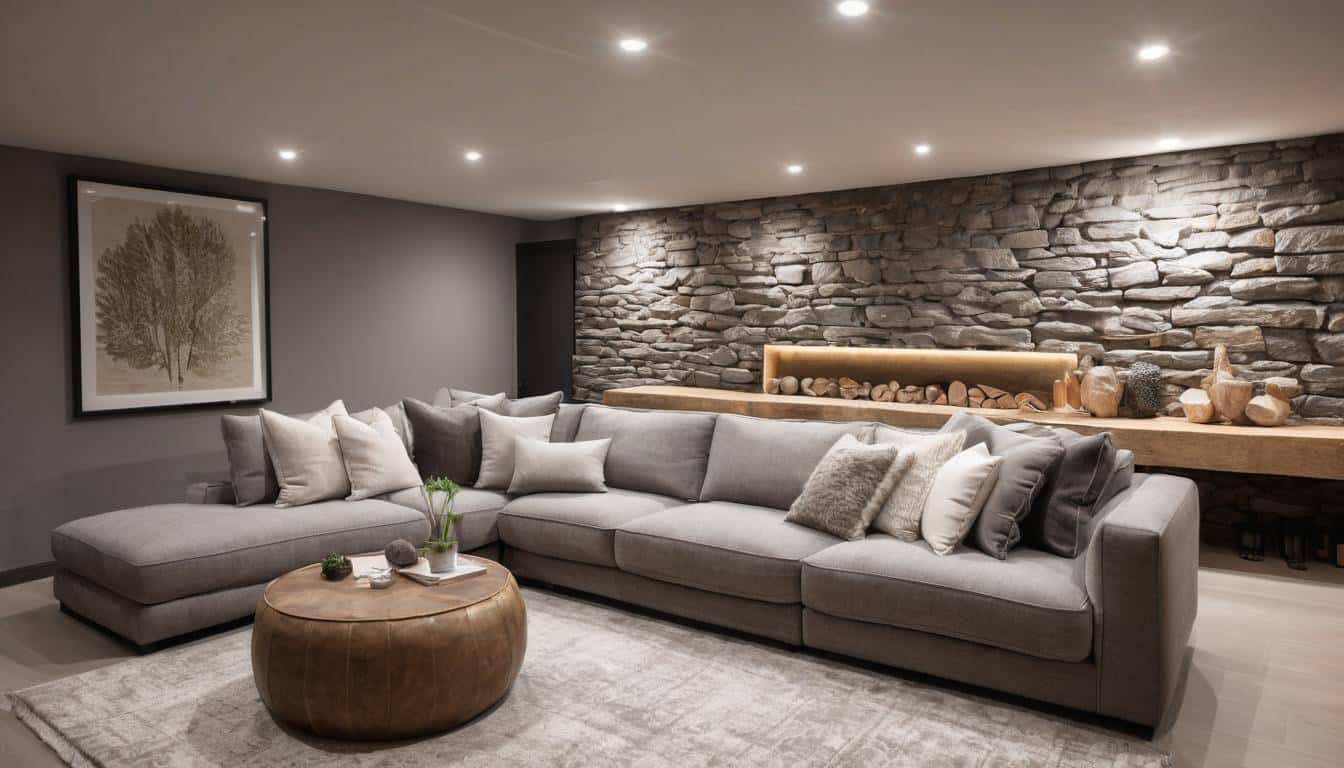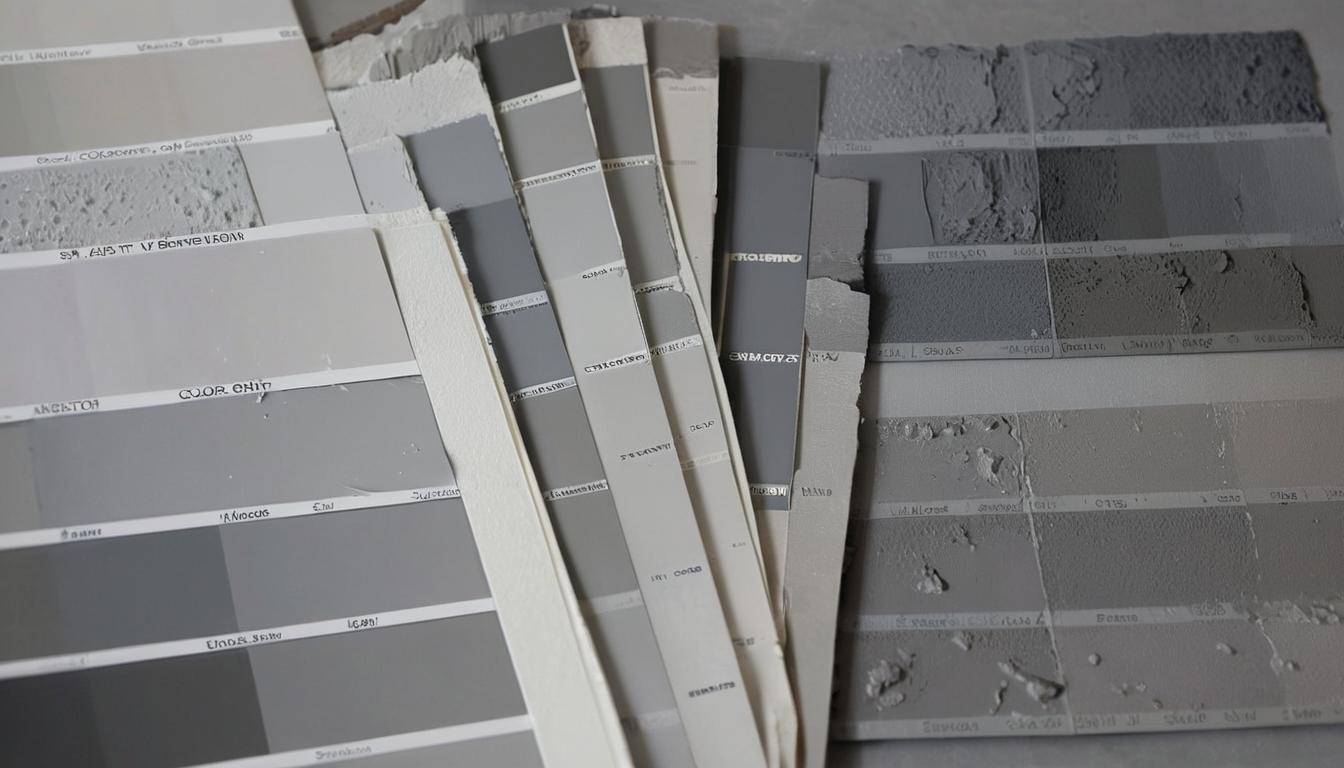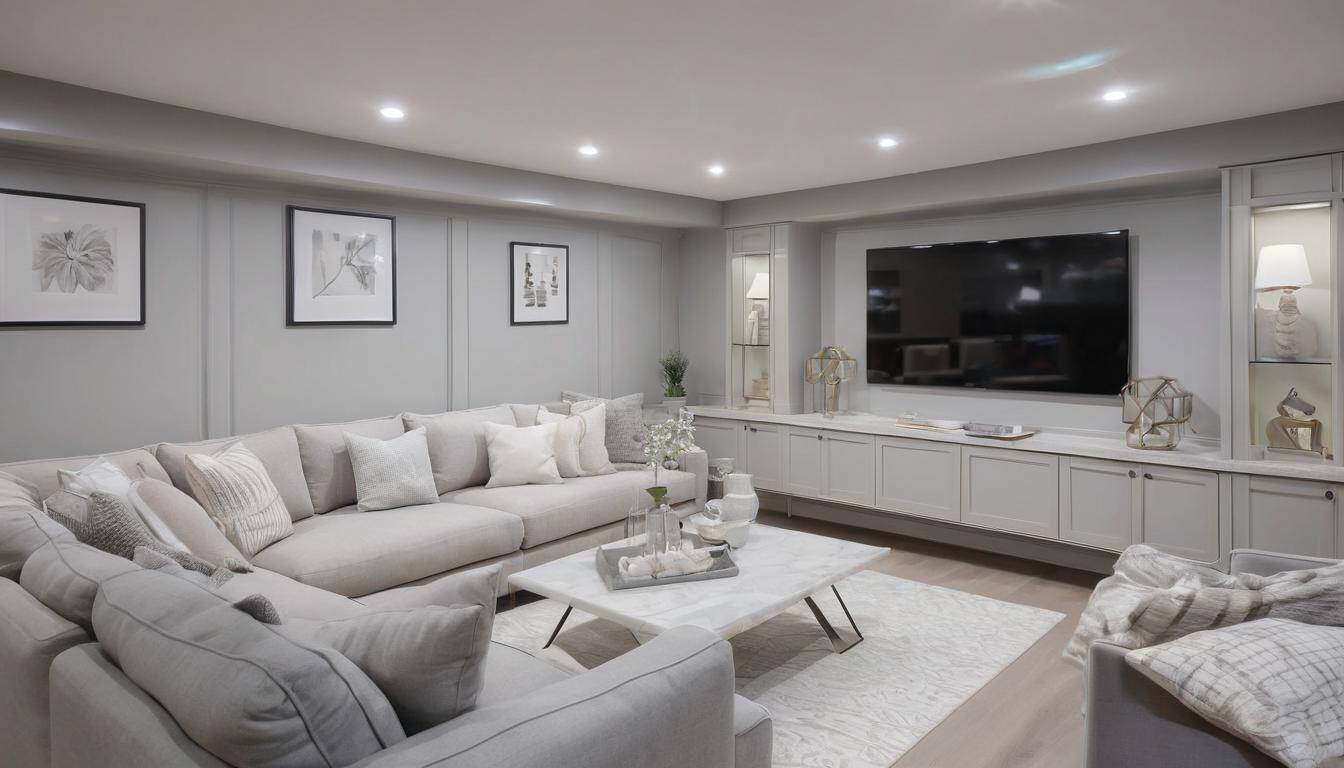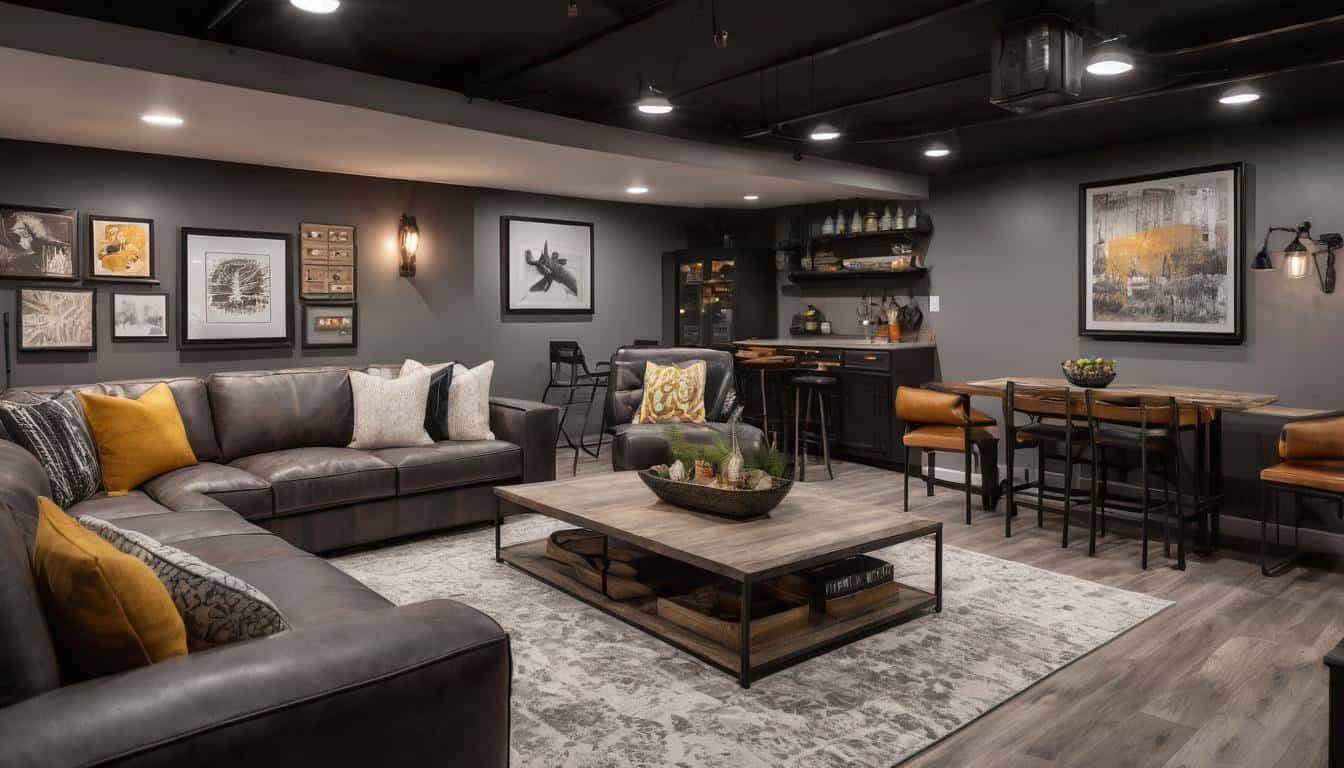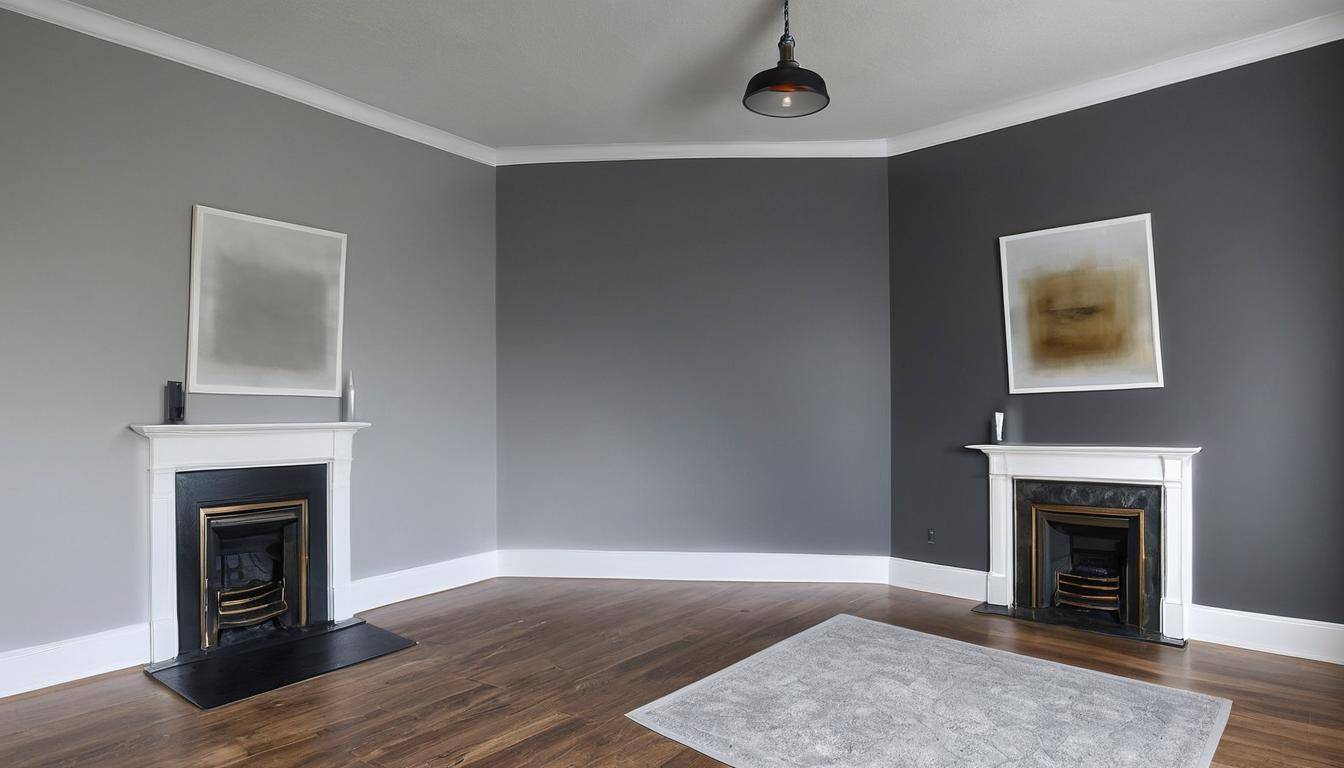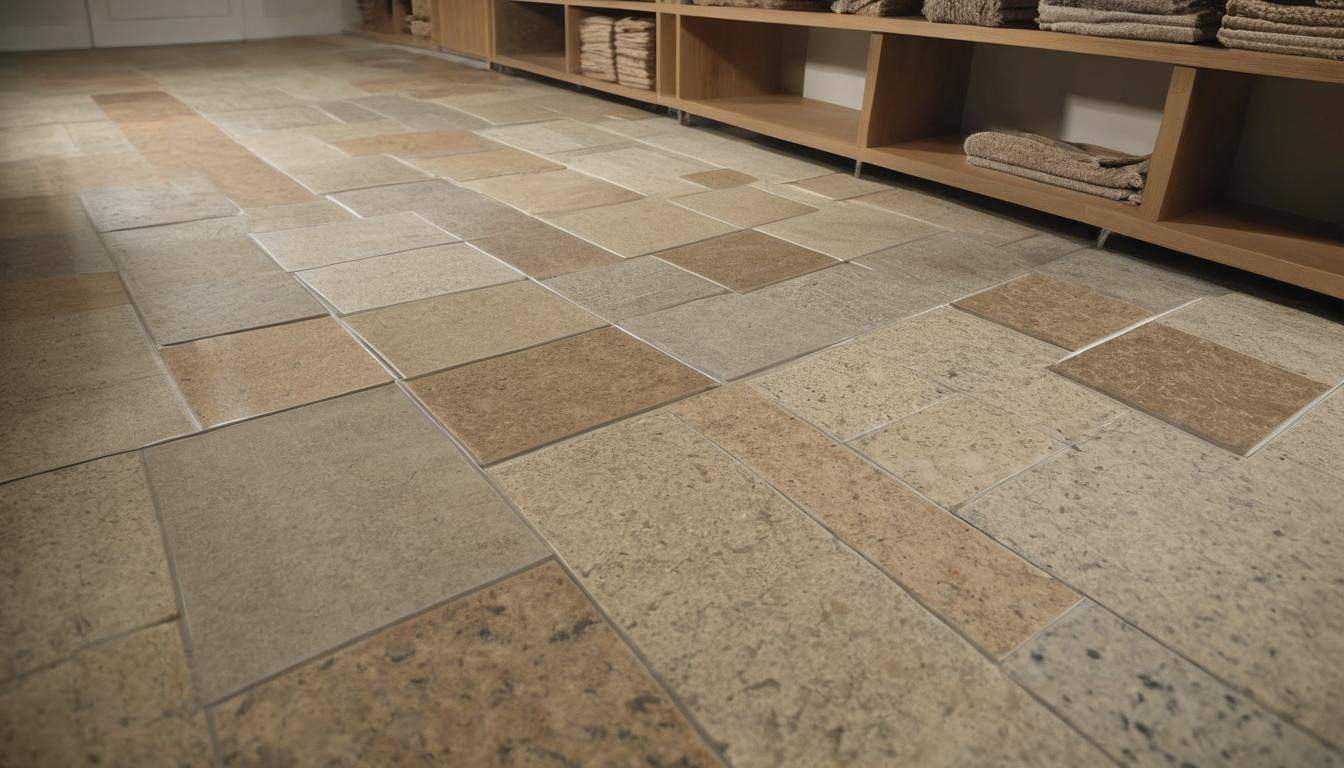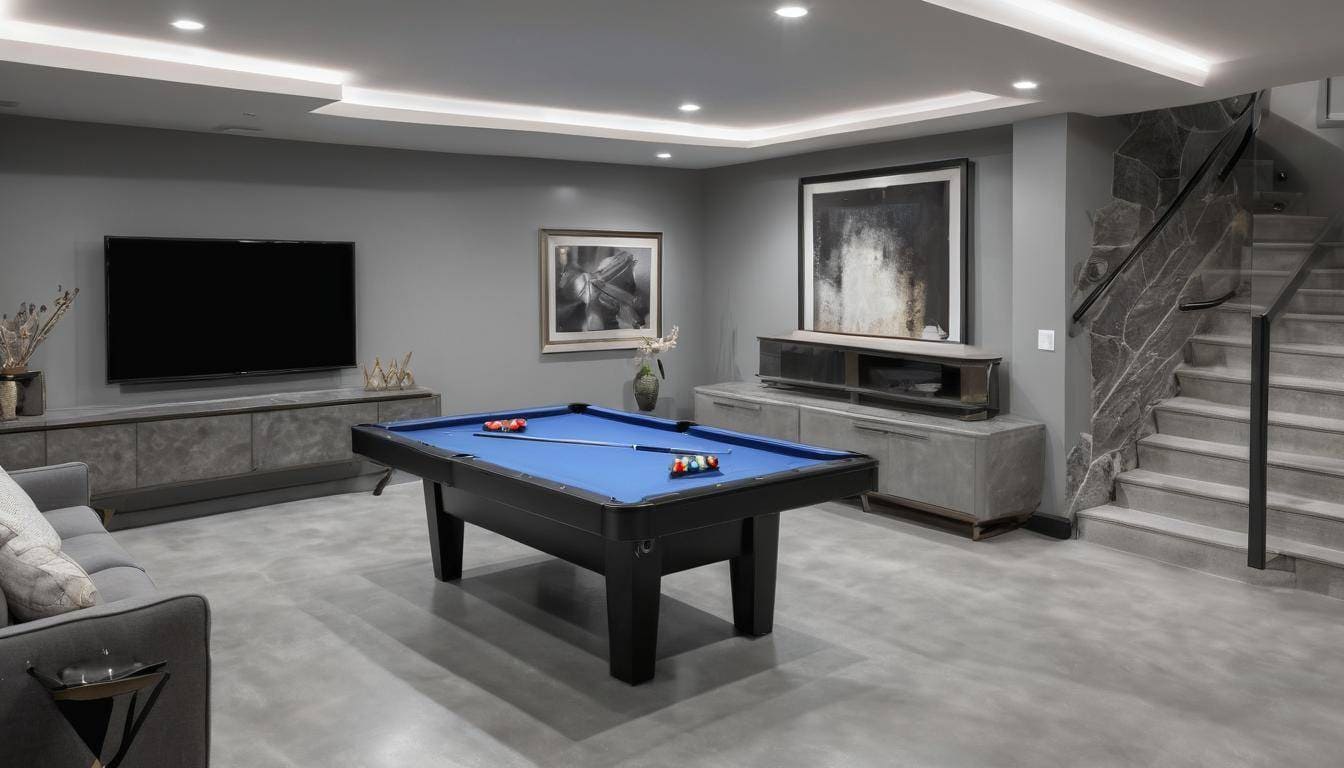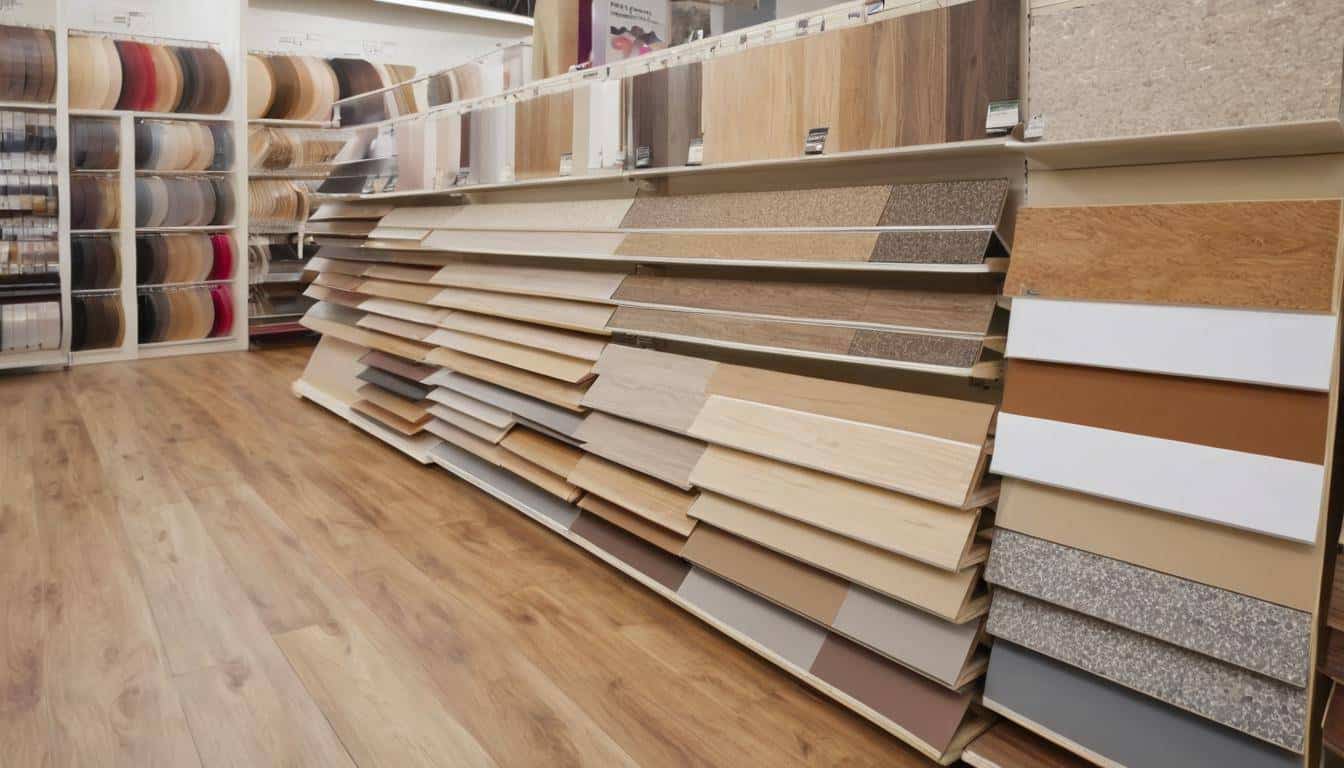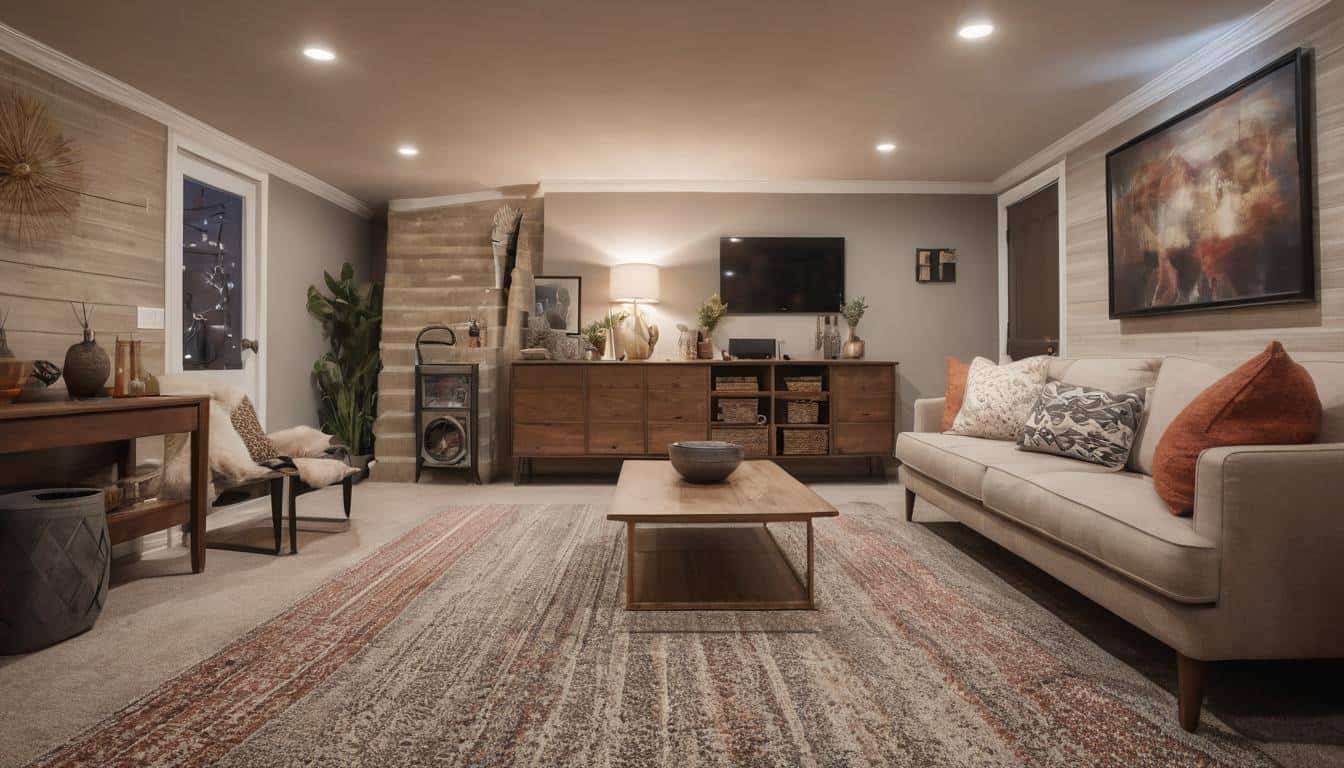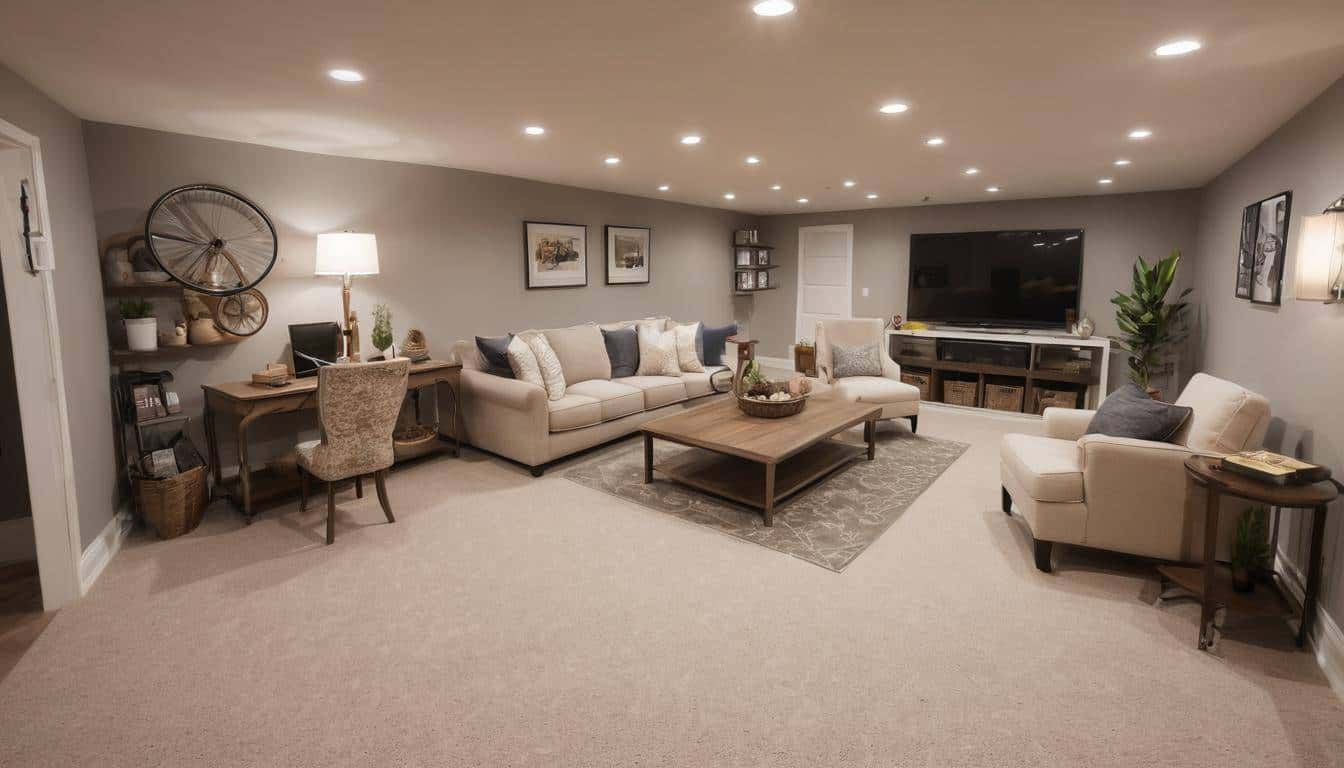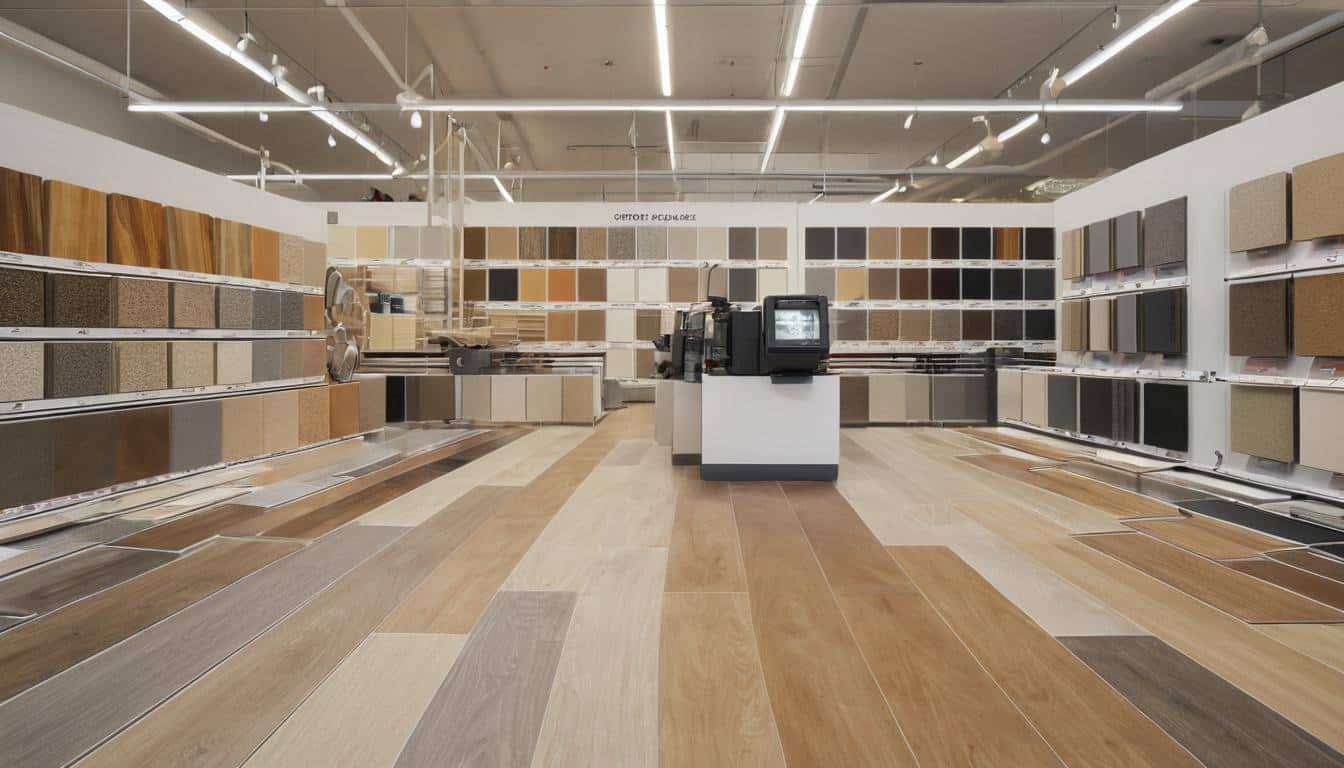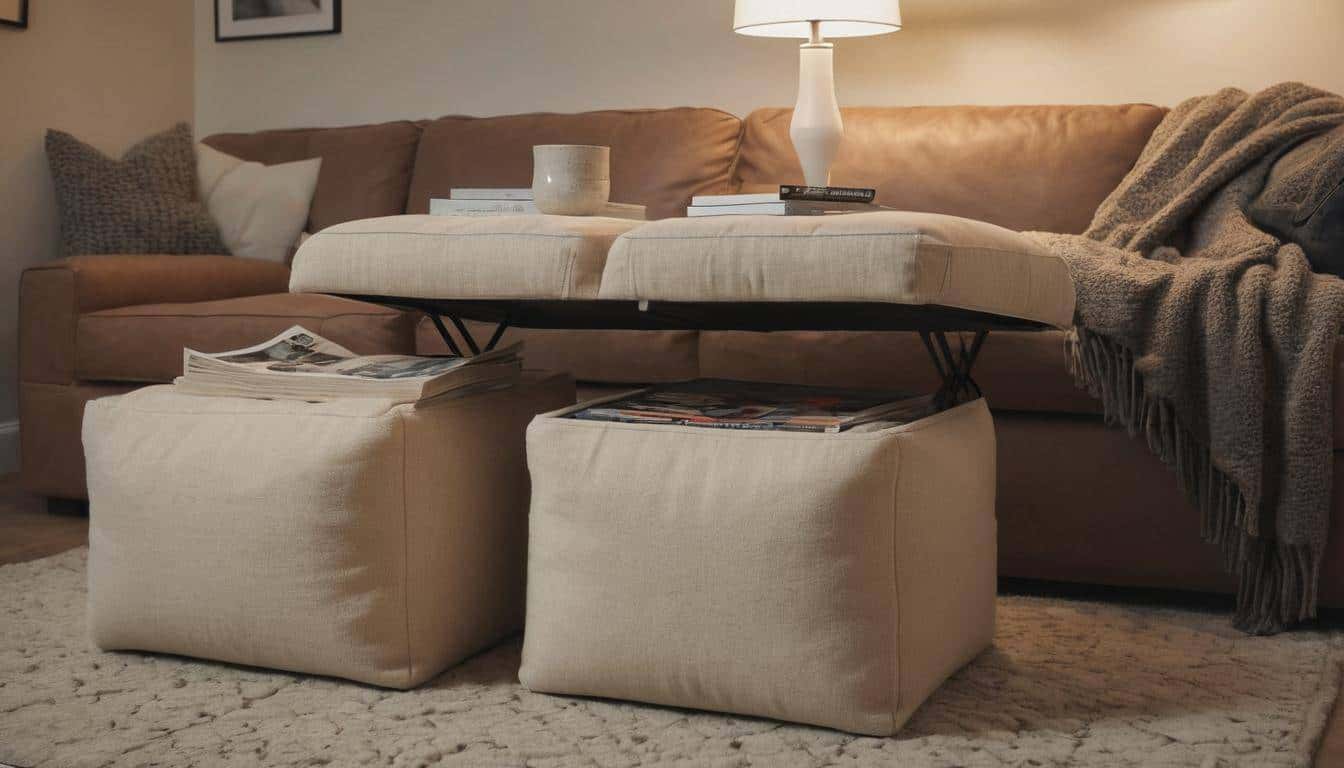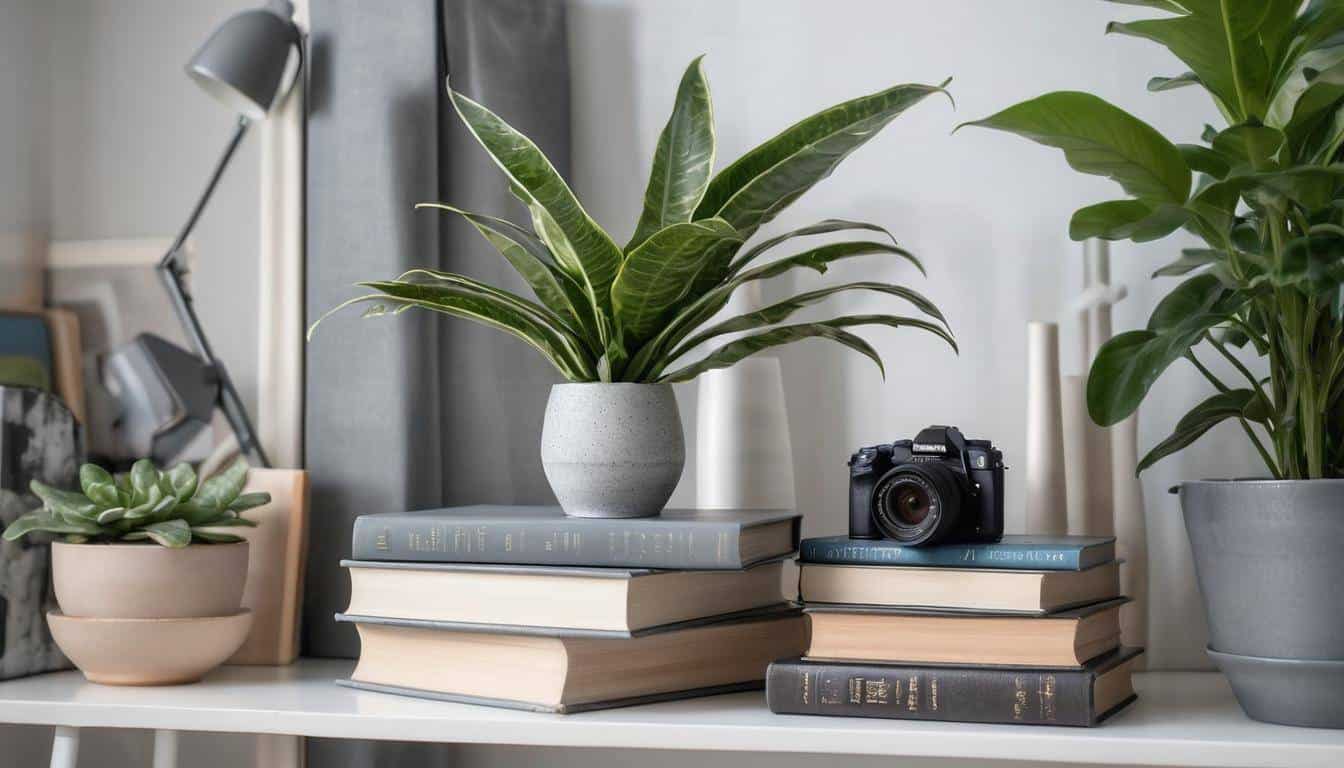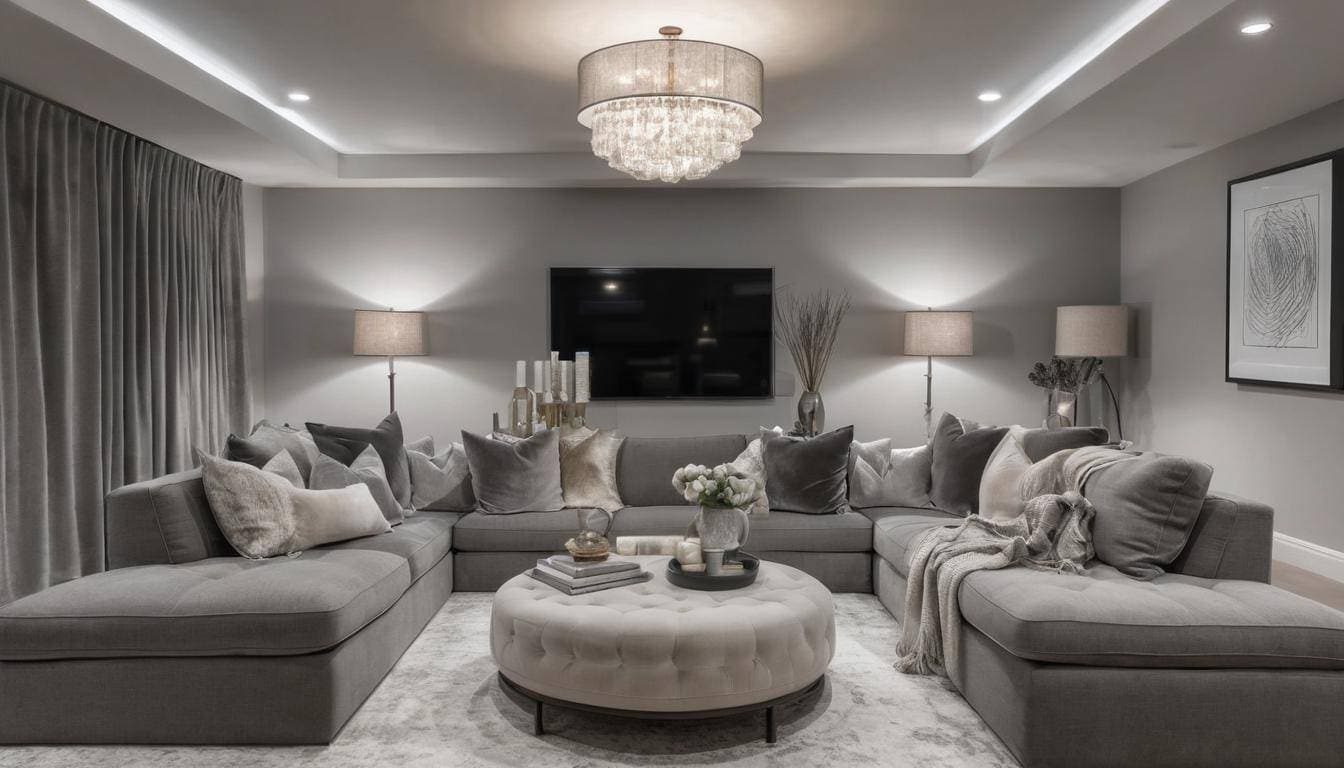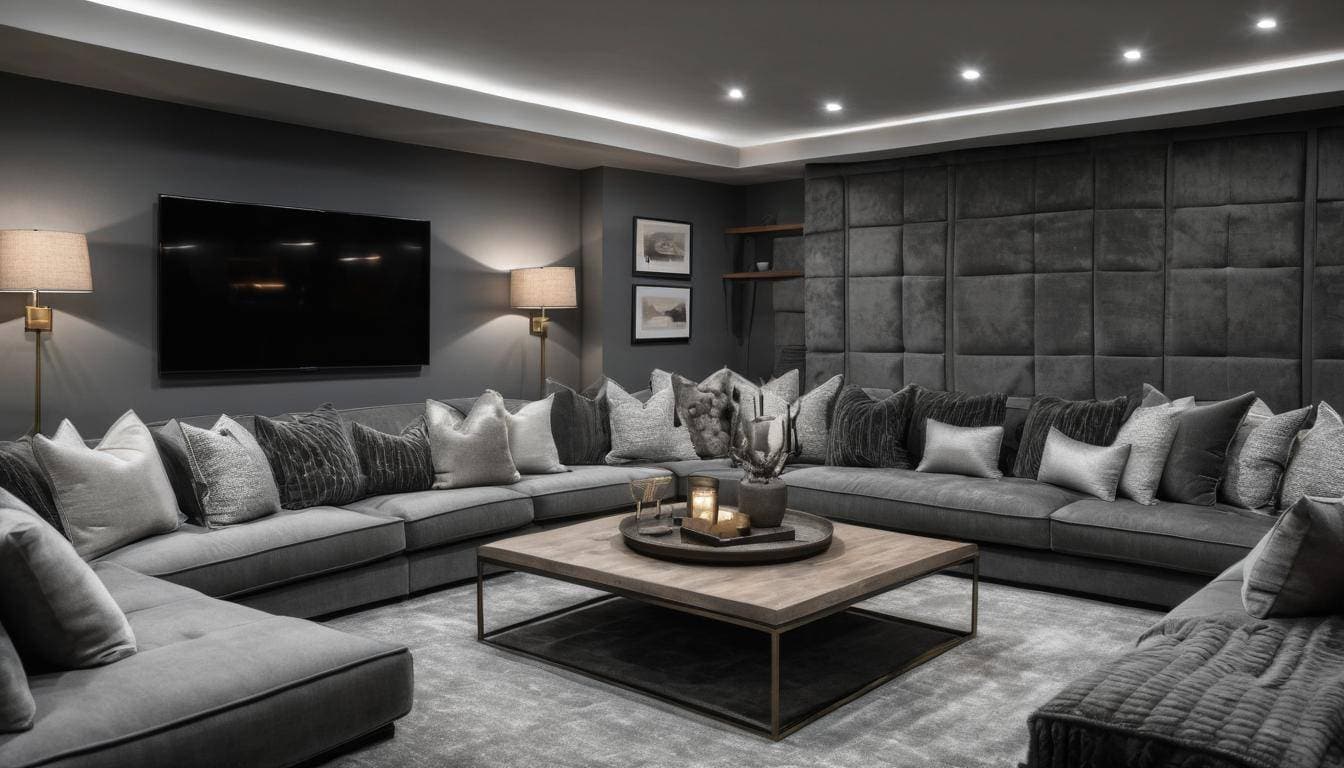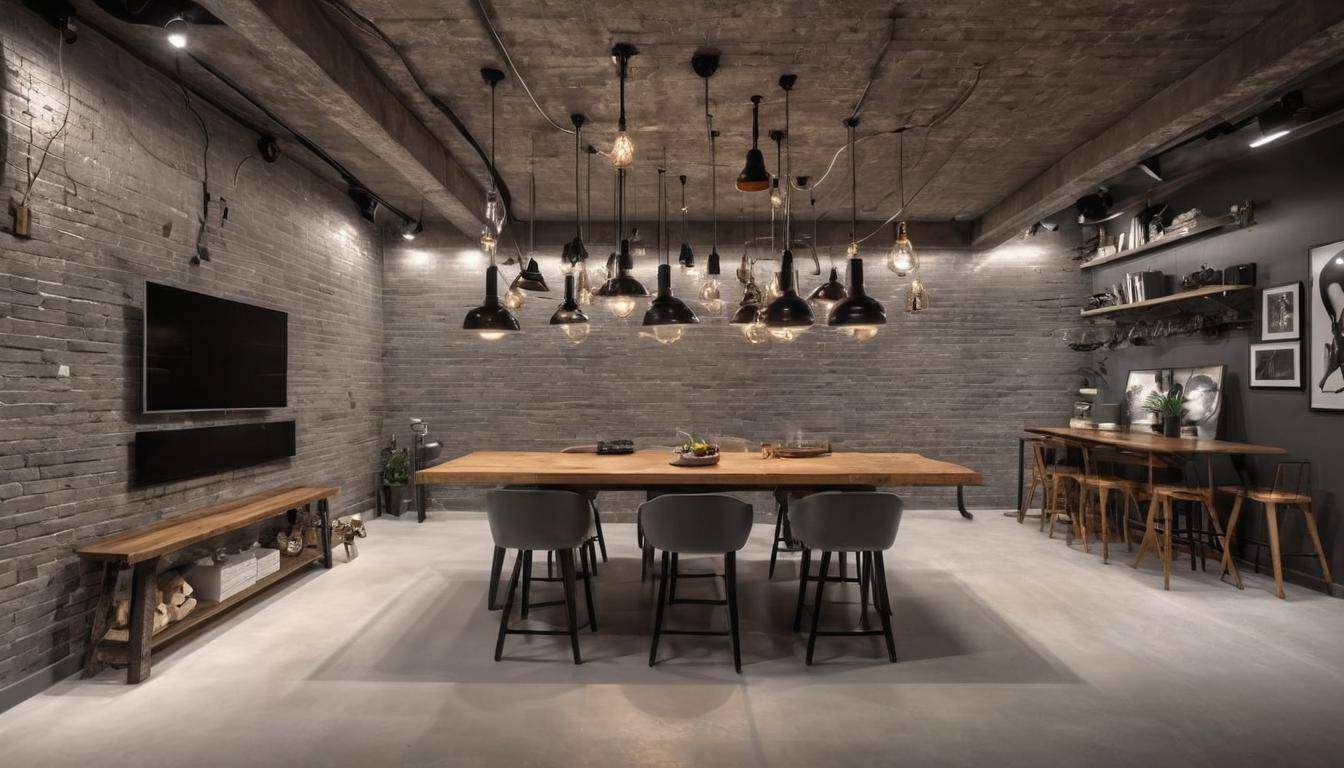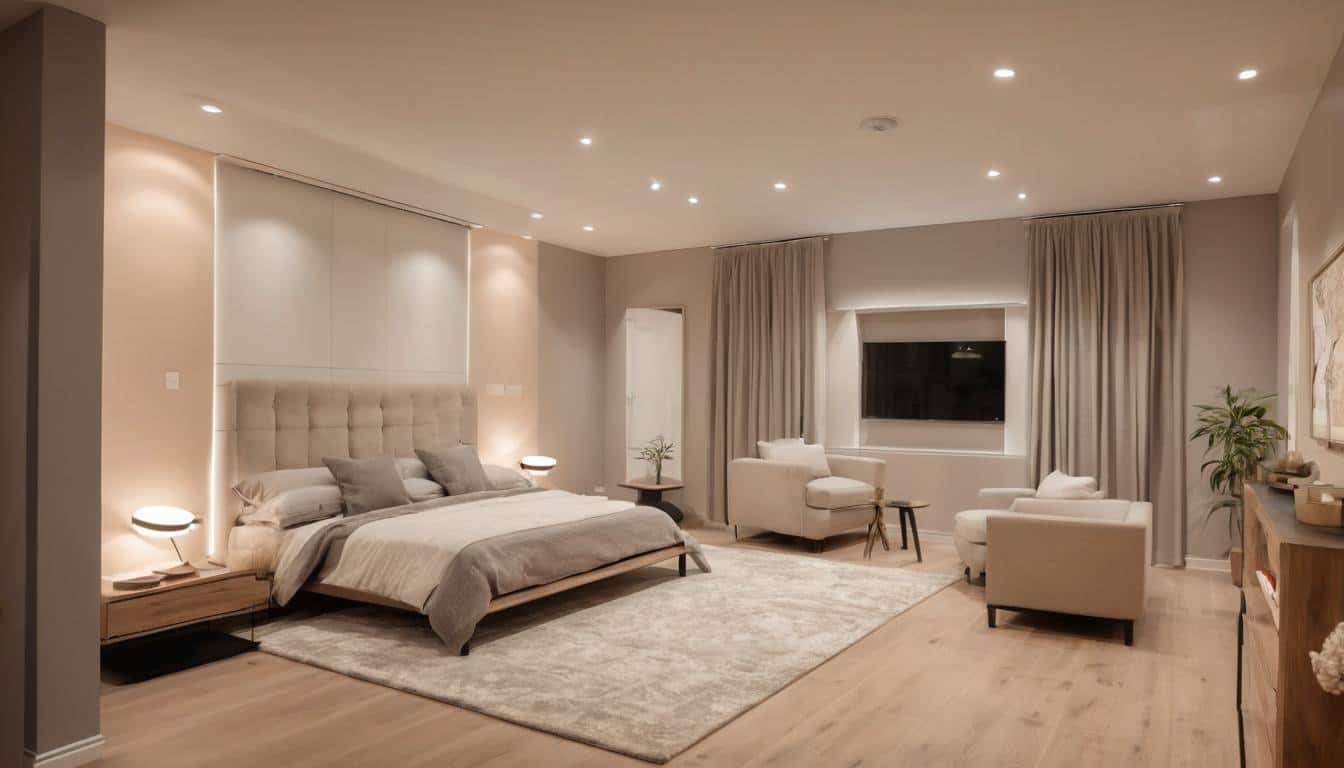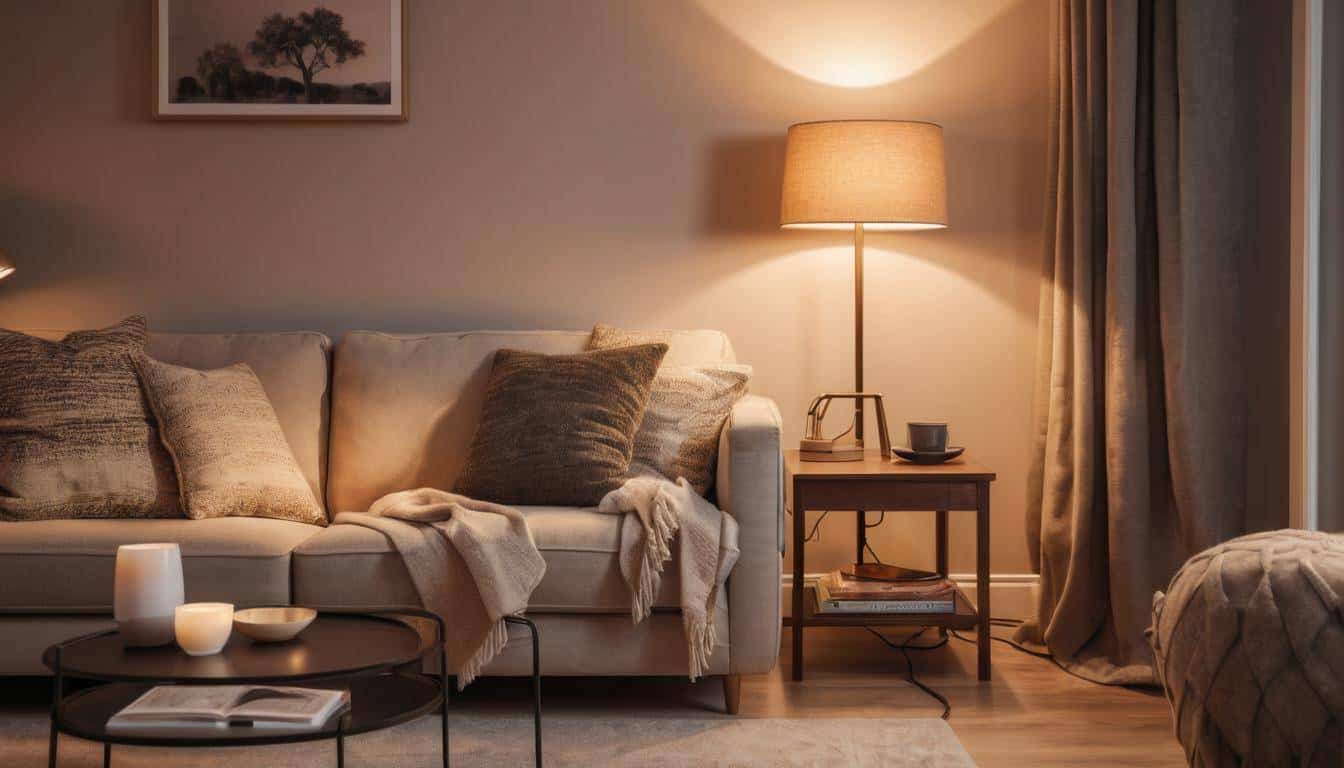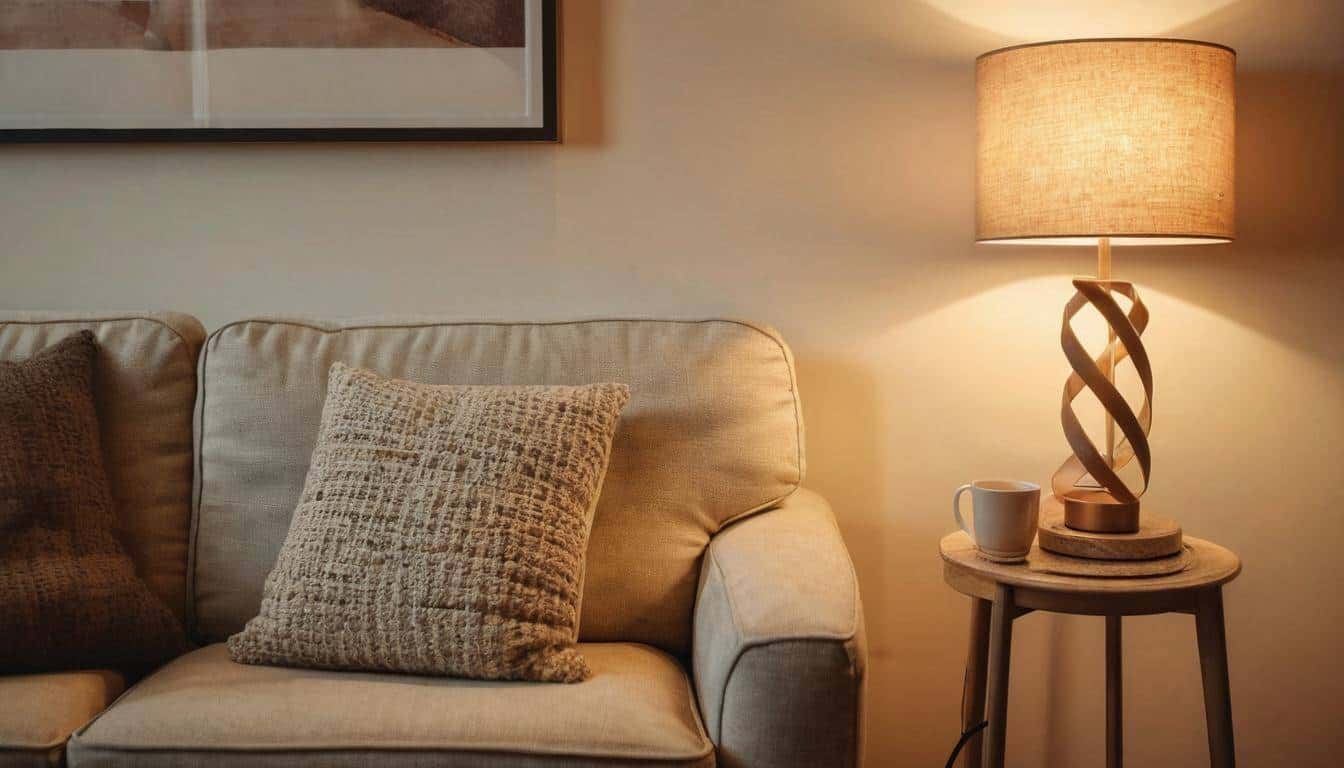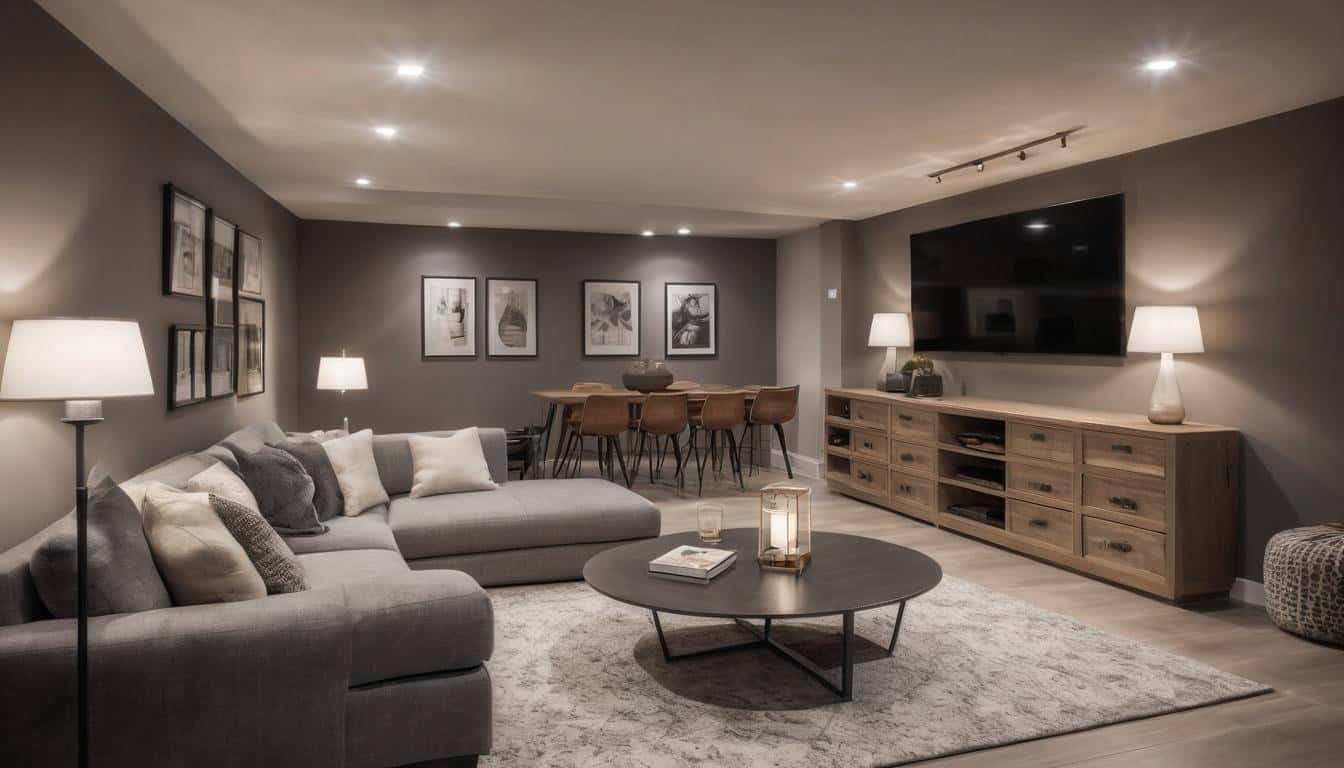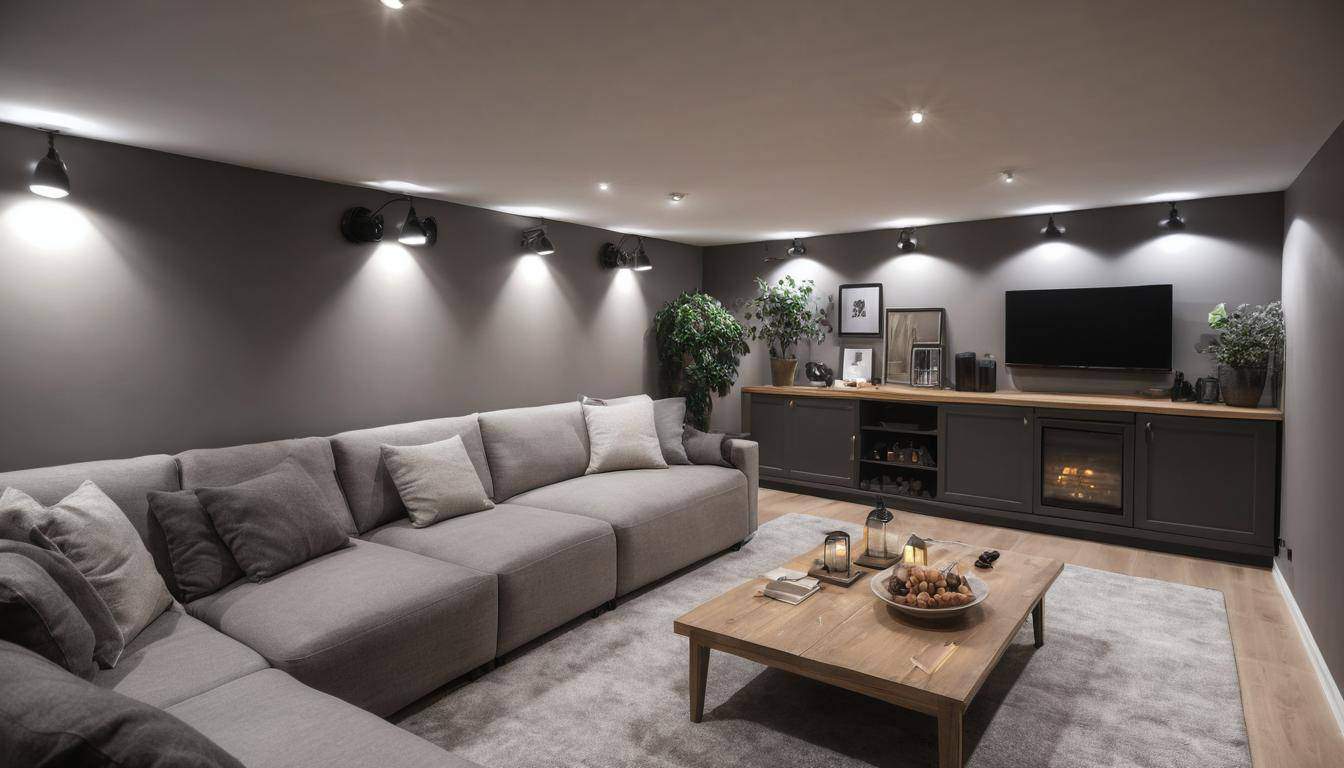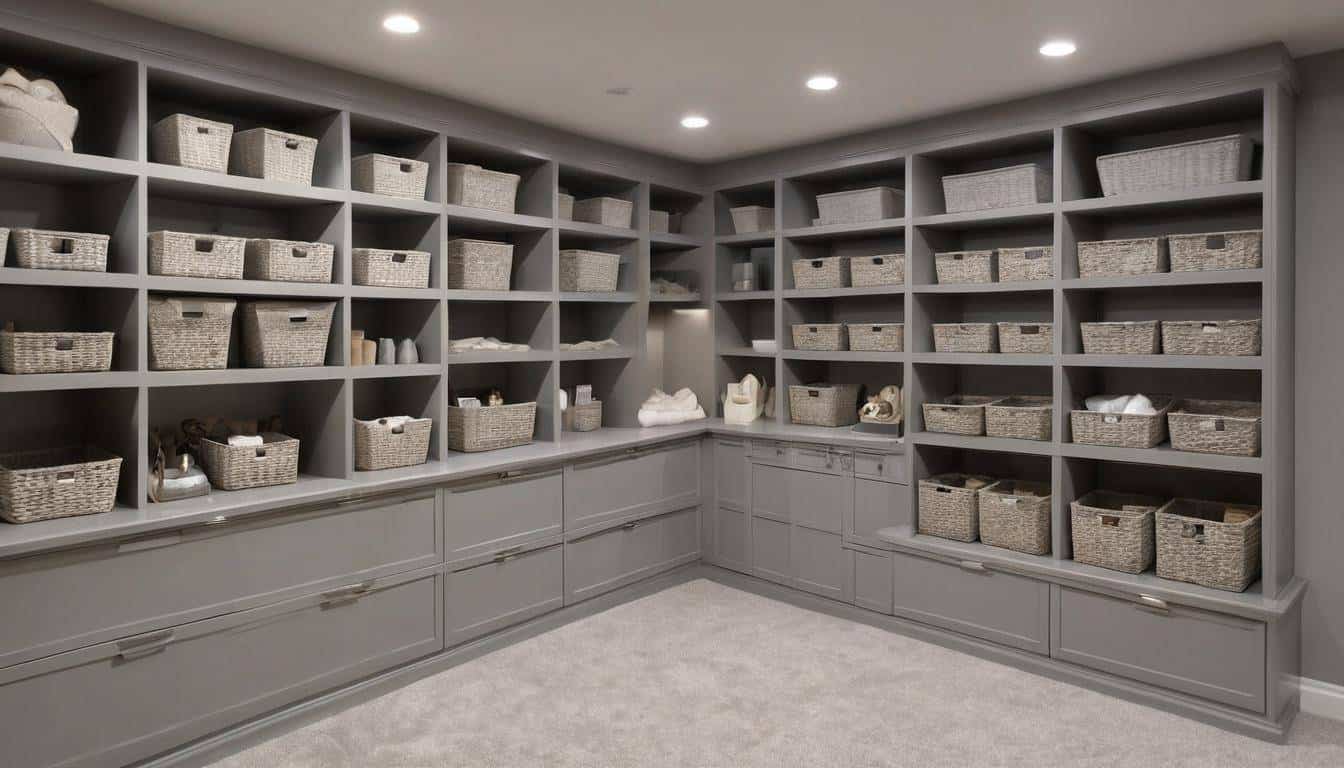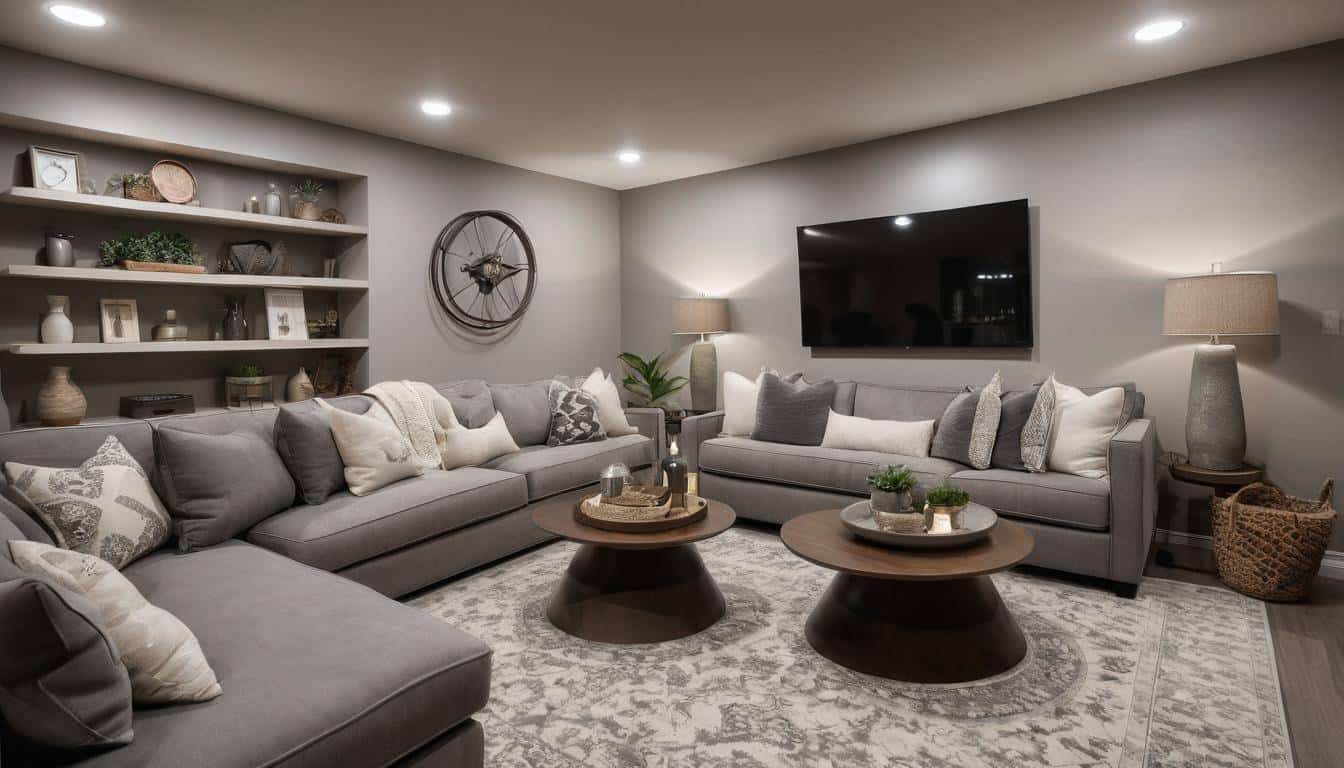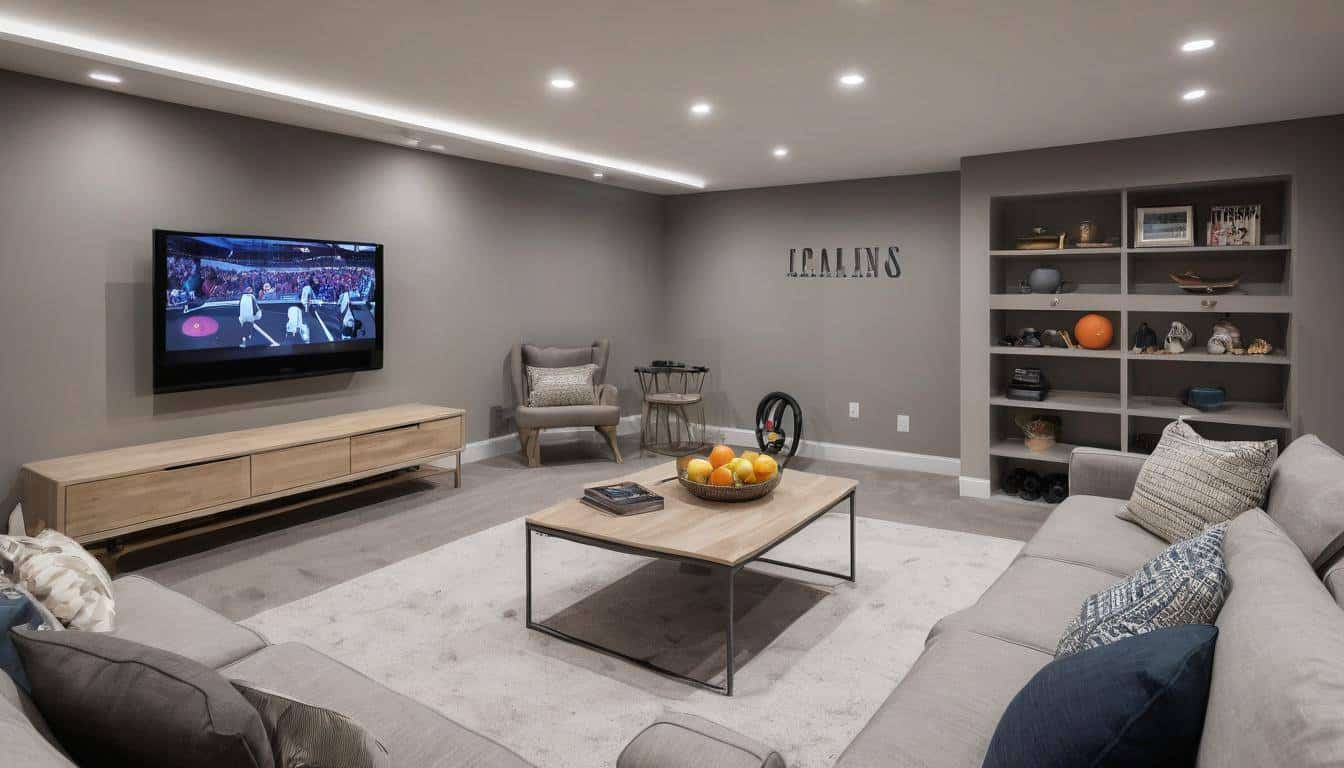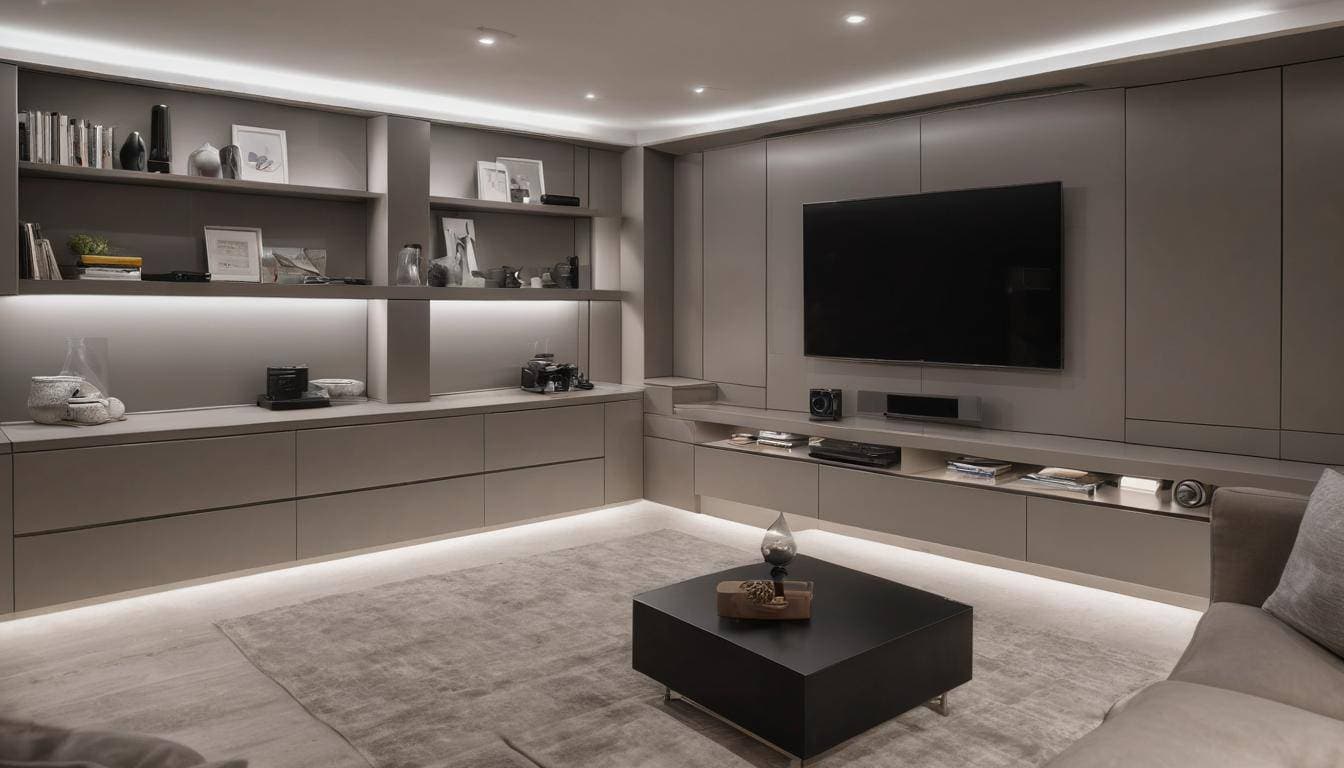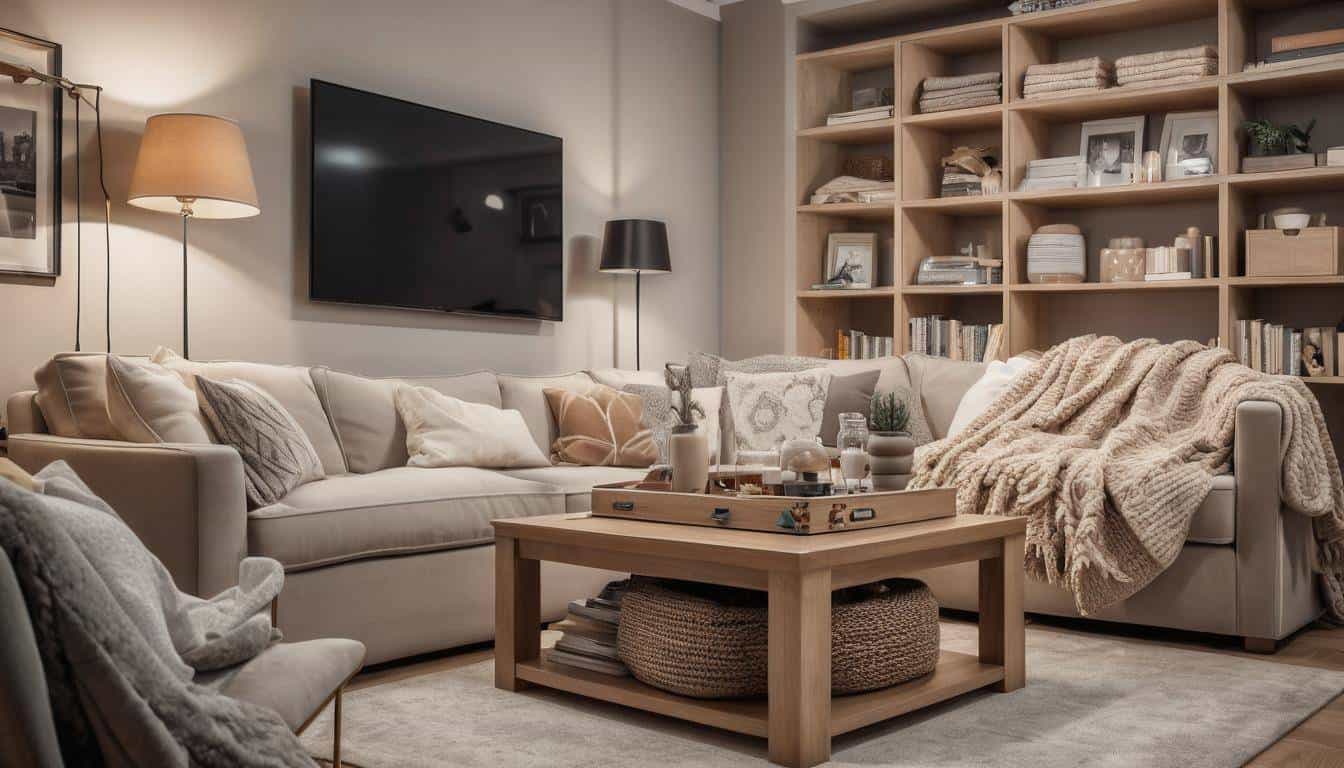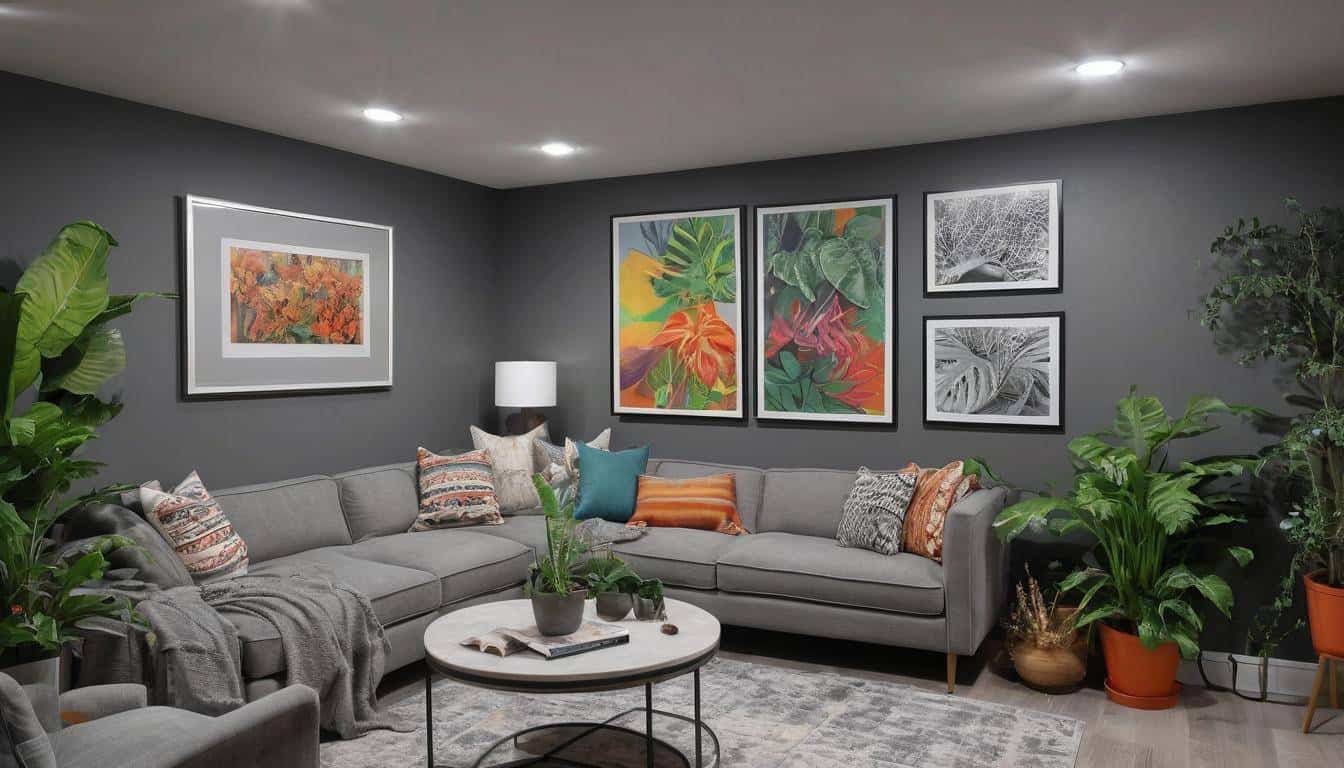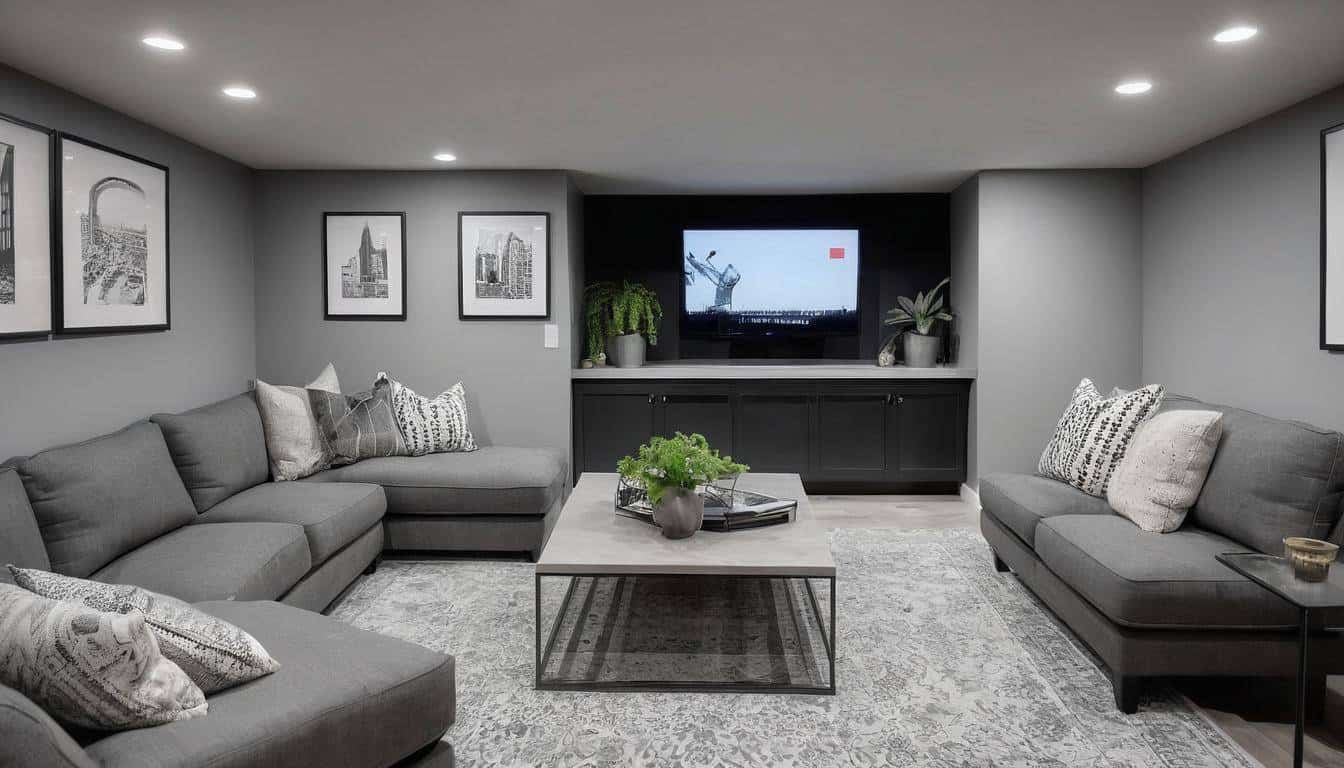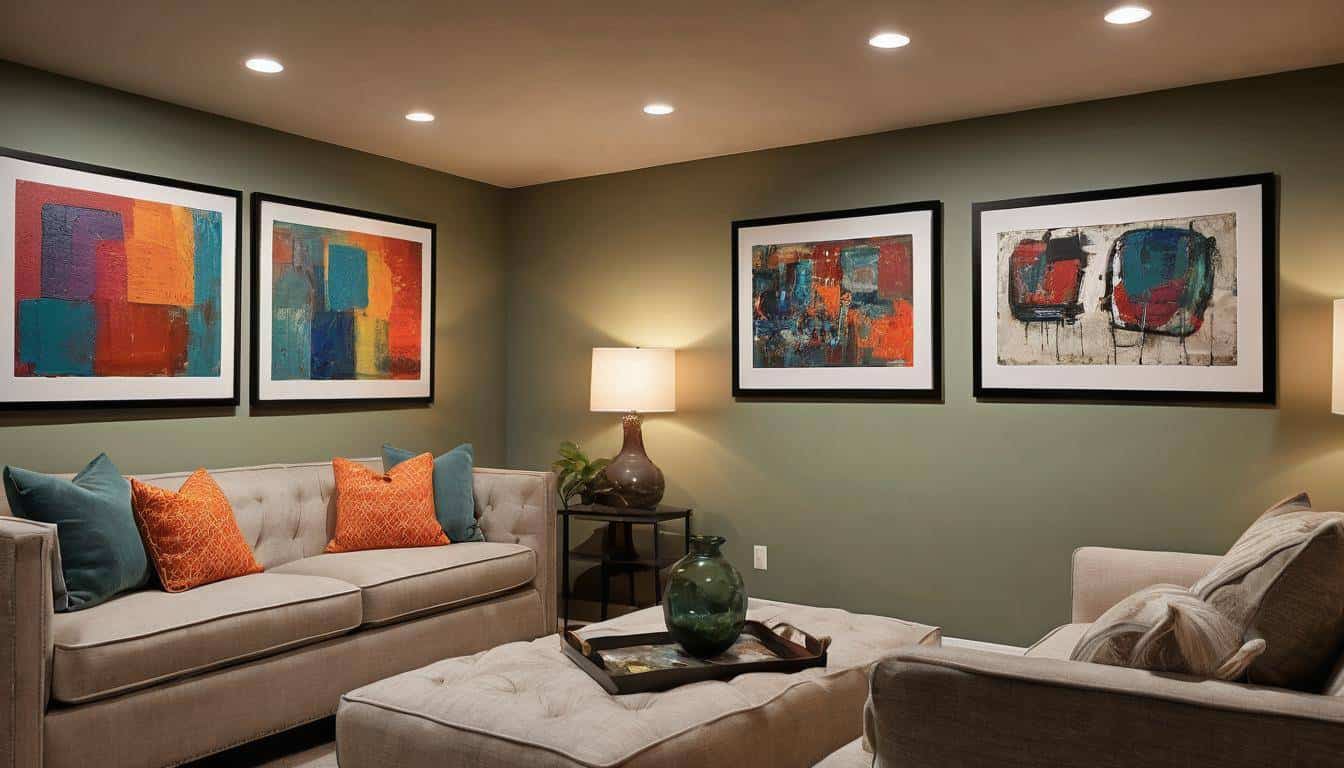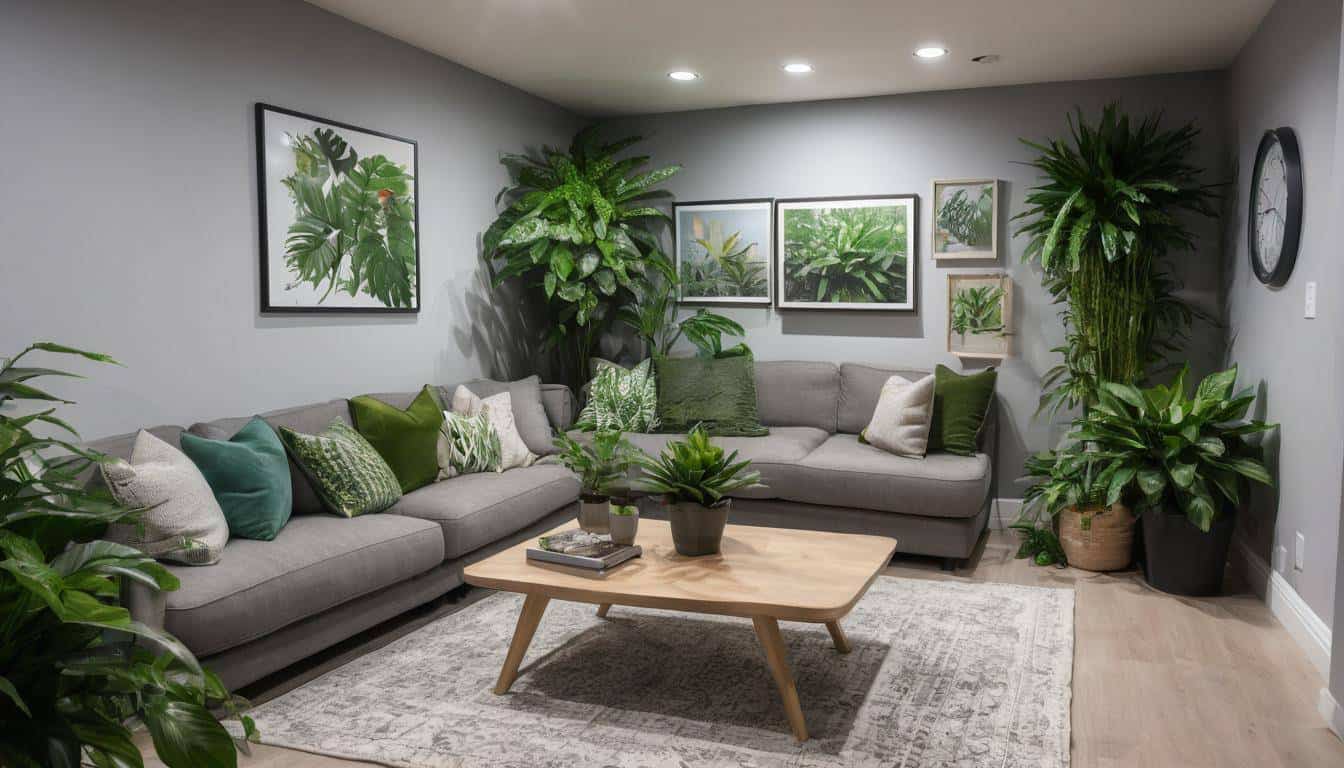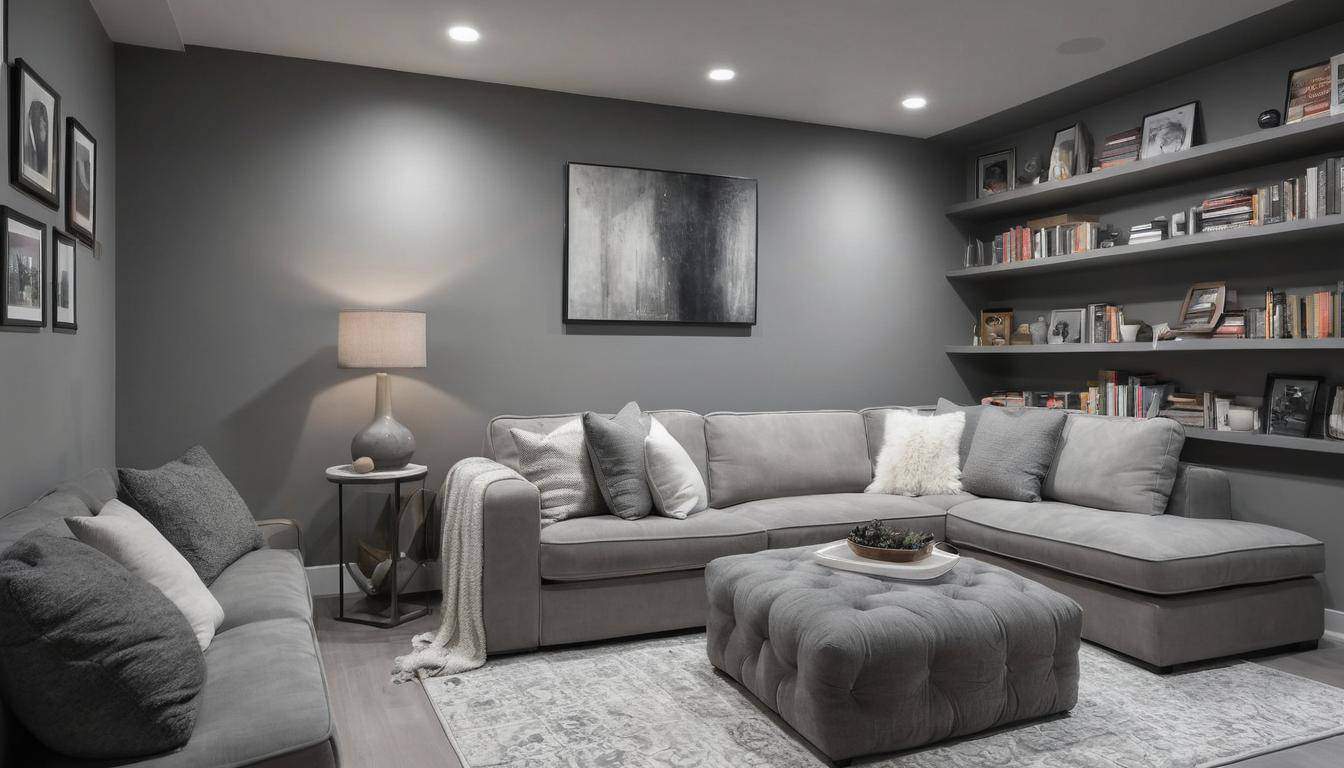
Creating a beautiful grey basement comes down to the right color selection. Lighter shades of grey work wonders in spaces with limited natural light, keeping your basement bright and inviting. It’s not just about avoiding darker tones that could make your space feel enclosed; lighter greys can also act like a blank canvas, making your furniture and décor pop. So, are you ready to pick the perfect shade? While grey is a popular choice, some homeowners opt for bolder options like black basements for a dramatic effect?
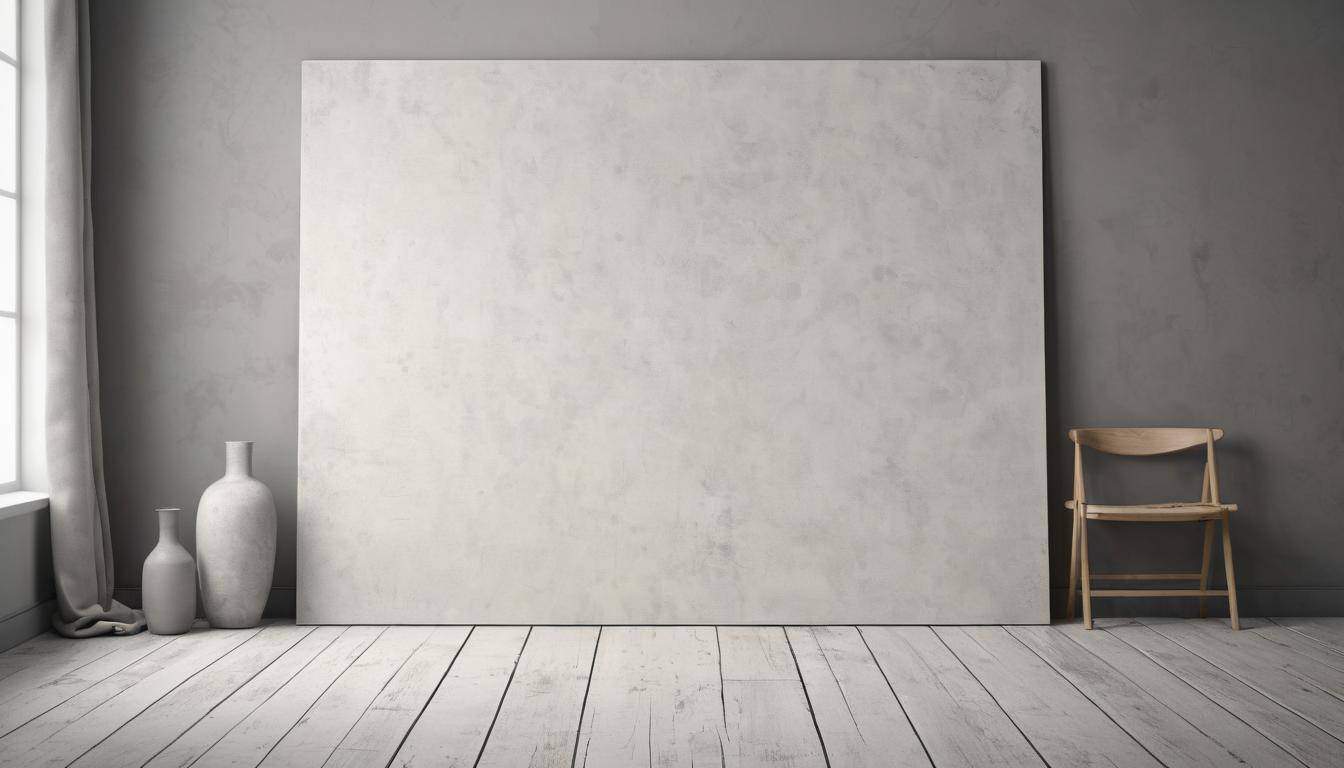
Grey can be used in basement design to evoke a sense of sophistication and modernity. Consider using lighter shades of grey for the walls and incorporating pops of darker grey or charcoal accents through furniture, decor, and textiles to create a stylish and inviting space. Embracing natural textures like wood or stone alongside layered lighting can further enhance the ambiance of your grey-themed basement. For those seeking a different vibe, navy blue basements offer a rich alternative design to evoke a sense of sophistication and modernity. Consider using lighter shades of grey for the walls and incorporating pops of darker grey or charcoal accents through furniture, decor, and textiles to create a stylish and inviting space. Embracing natural textures like wood or stone alongside layered lighting can further enhance the ambiance of your grey-themed basement.
Selecting the Right Shade for Grey Walls
Choosing the perfect shade of grey for your basement walls is crucial to creating a harmonious and inviting space. Whether your basement lacks natural light or you want to achieve a specific ambiance, the right shade can set the tone for the entire room. Let’s explore some factors to consider when deciding on the ideal grey hue for your basement walls.
Natural Light
When your basement has limited natural light, it’s essential to choose a lighter shade of grey. Lighter hues can help prevent the space from feeling dreary or enclosed, enhancing a sense of openness and spaciousness. By reflecting what little light there is, lighter greys can minimize the “cave-like” feeling often associated with basements, creating a more inviting and breathable atmosphere.
These lighter shades have higher Light Reflectance Values (LRV), measured on a scale of 0 to 100, with higher LRVs indicating greater light reflection. This reflective property makes them ideal for spaces with limited natural light as they can make the room feel brighter and more expansive. If you’re unsure about which shade falls into this category, popular paint brands like Sherwin Williams or Benjamin Moore offer a wide variety of light grey options with an LRV ranging from 70 to 80.
Warmth and Coziness
On the other hand, if you want to infuse your basement with a sense of warmth and coziness, consider opting for darker shades of grey. These deeper tones can create an intimate and comforting ambiance, especially when complemented with appropriate lighting fixtures and decor choices. Darker shades also have their place in well-lit basements where you want to create a snug retreat or enhance a modern industrial aesthetic using daring contrasts.
While these darker shades typically have lower LRVs of around 10 to 20 due to their reduced light reflection, they add depth and character to the space when balanced with strategic lighting sources such as stylish standing lamps or recessed lighting. When contemplating which dark grey would suit your vision best, look for hues that resonate with your desired level of warmth and coziness while still providing enough contrast against existing elements in the space.
Accent Wall
Creating an accent wall with a slightly darker or bolder shade of grey can significantly elevate the visual interest and depth of your basement. The accent wall serves as a focal point, adding personality and dimension to an otherwise monotonous color scheme. Additionally, it offers an excellent opportunity to experiment with different shades without overwhelming the entire room. For a more rustic approach, consider exploring ideas for rustic basements that incorporate natural elements and textures.
For example, if you’ve chosen a light grey as the main color for your walls, consider painting one area in a slightly darker tone to create a striking contrast. This subtle touch adds visual intrigue and can be further enhanced by showcasing artwork, photographs, or decorative items against this accent wall to draw attention and create a captivating focal point within the room.
By carefully considering these factors – natural light availability, ambiance goals, and accent wall opportunities – you can confidently select the perfect shade of grey that complements your basement’s unique style and enhances its overall appeal.
Understanding how different shades of grey influence the ambiance of your basement sets a strong foundation for creating the perfect living space. Now, let’s turn our attention to another critical aspect of interior design: choosing durable flooring for your basement.
Choosing Durable Flooring for Your Basement
Selecting the right flooring for your basement is crucial. From moisture resistance to comfort and insulation, a durable basement floor can make a big difference in the functionality and look of the space.
Waterproof and Moisture-Resistant
In basements, moisture is a top concern. Vinyl, laminate, or engineered hardwood are excellent choices because they offer outstanding water resistance and durability. These types of flooring materials are designed to withstand damp conditions and resist damage from moisture, making them ideal for basement environments. Additionally, they offer a wide range of styles and designs, allowing you to achieve the desired aesthetic while ensuring practicality.
Laminate flooring, for instance, boasts a multi-layer construction with a moisture-resistant layer that protects against spills and leaks. On the other hand, vinyl flooring is inherently waterproof and highly resilient, making it a reliable option for basements prone to moisture. Engineered hardwood also presents an attractive solution as it mimics the warmth and elegance of traditional hardwood while providing enhanced resistance to moisture-related issues.
Comfort and Insulation
In spaces where comfort and insulation take precedence, especially family rooms or entertainment areas within the basement, carpet tiles or rubber flooring can be excellent choices. Carpet tiles offer plush underfoot cushioning, warmth, and sound insulation properties which contribute to creating a cozy ambiance. On the other hand, rubber flooring provides remarkable comfort underfoot and helps to insulate against cold floors. These options are ideal for creating comfortable and welcoming basement living spaces.
Both carpet tiles and rubber flooring are available in a variety of colors, patterns, and textures, allowing seamless integration with different interior design schemes. Moreover, these materials are known for their easy installation process, making them convenient options for transforming the basement into a cozy retreat or leisure area.
Knowing the unique demands of your basement space is essential when considering different flooring options. By prioritizing both durability and functional attributes in your choice of flooring material, you can create a space that not only looks beautiful but also meets practical requirements.
Looking beyond the flooring aspect, let’s now explore how to furnish your grey basement space to achieve a harmonious blend of style and functionality.
Finding the Ideal Furniture for a Grey Basement
When furnishing a grey basement, thoughtful space utilization and complementary colors play a crucial role in making the space inviting and functional.
Basements often have unique layouts or limited space compared to other rooms in the house. Therefore, it’s important to choose furniture that fits the scale of your basement while leaving enough room for movement. Sectional sofas are great for filling up larger spaces, and they offer flexibility when arranging your seating area. They can be configured in multiple ways to make the best use of your available space, whether for lounging or entertaining. Ottomans with hidden storage are also smart choices—doubling as a footrest or extra seating while providing concealed storage for items like blankets, magazines, or toys.
Another way to make the most of your basement space is by incorporating wall-mounted shelving systems. These not only keep your belongings organized but also free up valuable floor space. You can use them to display decorative items, store books, or even showcase indoor plants, adding life and personality to the area without cluttering it.
Complementing Colors
A cool-toned grey color scheme sets the tone for your basement, providing a calming and versatile backdrop. To complement this foundation, consider incorporating furniture in contrasting colors like white, cream, or pastel shades. These hues can create visual balance within the space and prevent it from feeling too monochromatic.
If you prefer a more contemporary look, consider using pops of bold colors to add an energetic contrast against the subdued grey backdrop. For example, vibrant accent chairs or throw pillows in shades of yellow, teal, or coral can infuse energy into the space while still adhering to the overall grey theme. Alternatively, an olive green basement can provide a unique and refreshing ambiance that complements various design styles.
It’s all about creating a cohesive look while allowing certain pieces to stand out and make a statement. In essence, achieving an inviting and harmonious aesthetic is about layering various tones and textures within your chosen color palette.
Implementing these ideas will help you create a balanced and functional living space in your beautiful grey basement, providing comfort and style for you and your family to enjoy.
Preparing an enticing ambiance involves not only the right furniture but also carefully selected light fixtures. Let’s now explore how you can illuminate your grey basement with fixtures that brighten up every corner.
Light Fixtures to Brighten Up Your Space
When it comes to basements, lighting plays a crucial role in creating an inviting and comfortable ambiance. Since basements typically have limited natural light, incorporating the right light fixtures can make a world of difference in transforming the space into a cozy retreat.
One of the most popular choices for basement lighting is recessed LED lights. These fixtures are installed directly into the ceiling, providing ample illumination without taking up valuable headspace. The evenly distributed light from recessed lights helps to prevent any harsh shadows, ensuring a well-lit and open feel to the room.
Key Considerations for Recessed Lighting
Aspect |
Recommendation |
|---|---|
Lumens |
Aim for an average of 1500-3000 lumens |
Color Temperature |
Choose warm color temperature from 2700-3000 K |
Wattage |
Opt for LED bulbs with 8-12 watts for efficiency |
In addition to recessed lighting, floor and table lamps are an effective way to add warmth and flexibility to your basement lighting scheme. By strategically placing these lamps around the room, you can create zones of light and tailor the illumination levels for different activities.
For instance, placing a floor lamp near a reading nook or a table lamp on a side table next to a cozy chair can provide focused illumination for activities like reading or crafting while adding a touch of ambient light to the room.
Furthermore, the variety of designs and styles available in floor and table lamps allows you to complement the overall decor and theme of your grey basement. Whether you prefer modern, industrial, or traditional aesthetics, there’s a diverse selection of floor and table lamps to suit your personal style and elevate the visual appeal of the space.
By carefully selecting and combining recessed LED lights with strategically placed floor and table lamps in your grey basement, you can create a balanced and inviting atmosphere that enhances both functionality and aesthetics.
Now equipped with an understanding of how to illuminate your basement effectively, let’s proceed to explore practical storage solutions that bring order to this versatile space.
Storage Solutions for an Organized Basement
It’s no secret that basements often become the catch-all for everything from seasonal decor to sports equipment, and it’s easy for this space to become a cluttered mess. The good news is that there are numerous ways to maintain order in your basement with some clever storage solutions. Let’s start with built-in shelving.
Built-in Shelving
Built-in shelving is a wonderful addition to any basement, especially when you’re aiming for an organized and spacious look. By installing built-in shelves along the walls, you can provide ample storage for books, decor items, and media equipment. Not only does this help to keep the space organized, but it also allows you to display your favorite items in an aesthetically pleasing way.
Here’s an idea: Consider using built-in shelves not just for storage, but also as a way to showcase your favorite books or art pieces. By combining functionality with visual appeal, you can transform your basement into a truly inviting and multifunctional space.
Moreover, built-in shelving can be tailored to suit the specific needs of your family members – whether it’s creating a dedicated space for kids’ toys or displaying a collection of vintage vinyl records. The flexibility of built-ins allows you to adapt the space to accommodate various storage needs while maintaining a cohesive and organized look.
Multi-Functional Furniture
In addition to built-in shelving, multi-functional furniture can work wonders in maximizing storage in your basement. Opting for furniture pieces with built-in storage, such as ottomans with hidden compartments or coffee tables with shelving underneath, can help you make the most of the available space while keeping clutter at bay.
Pro tip: Look for durable and stylish multi-functional furniture pieces that not only offer storage solutions but also complement the overall design aesthetic of your basement. This way, you can seamlessly integrate practicality with style.
The beauty of multi-functional furniture lies in its ability to serve dual purposes – providing storage while also serving as a functional and visually appealing element in your basement. Whether it’s stowing away extra blankets or storing board games, these furniture pieces can contribute to an organized and welcoming environment.
With these thoughtful storage solutions, you can transform your basement into a beautifully organized space where everything has its place, allowing you to fully enjoy the comfort and versatility of this additional living area in your home.
Adding the Perfect Finishing Touches to Your Basement
The foundation of any interior design project lies in the details that bring a room to life. When it comes to basements, incorporating the right finishing touches can significantly enhance the ambiance and functionality of the space. Let’s focus on two key elements that can elevate your grey basement: artwork and decor, as well as the introduction of plant life.
Artwork and Decor
When selecting artwork and decor pieces for your basement, it’s essential to consider the existing color scheme and layout of the space. In a grey basement, you have a versatile canvas to work with, allowing you to play with various shades and textures. Abstract paintings, decorative mirrors, or statement wall art can be excellent choices to add visual interest and a touch of personality to the room.
Consider selecting artwork that complements the cool tones of grey while adding warmth and contrast. For instance, vibrant abstract paintings with pops of color can infuse energy into the space, while decorative mirrors can create the illusion of added depth and luminosity in a basement with limited natural light. Additionally, incorporating statement wall art, such as oversized prints or sculptural pieces, can serve as captivating focal points, drawing attention and igniting conversations.
Plant Life
Introducing indoor plants into your basement is a wonderful way to bring a touch of nature indoors, creating a lively atmosphere and enhancing air quality. When selecting plants for basements with limited natural light, it’s important to choose species that are tolerant of low-light conditions. Not all plants thrive in darker environments, so opting for varieties such as snake plants, pothos, peace lilies, or ZZ plants can ensure that your green companions flourish even without abundant sunlight.
In addition to adding aesthetic appeal, indoor plants also contribute to air purification and moisture regulation, fostering a healthier environment in your basement. Their presence can instantly enliven the space while promoting a sense of tranquility and connection to nature amid an urban setting.
By integrating carefully curated artwork and decor alongside thriving indoor plants, you can transform your grey basement into a harmonious retreat that exudes style, comfort, and vibrancy—elevating it from simply being an extra living space to becoming a captivating extension of your home’s interior.

